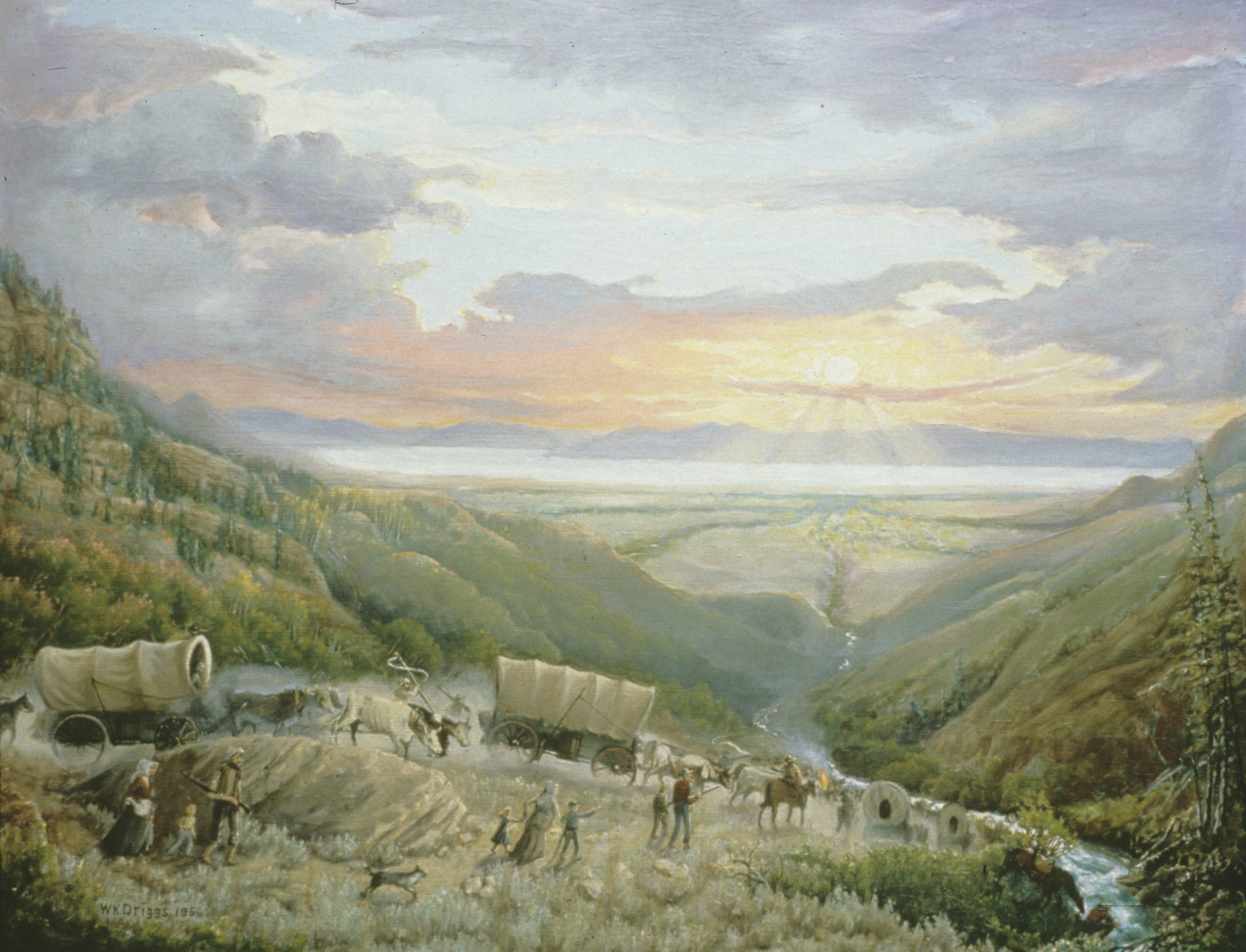
All eight of my Grandma Fike’s great grandparents and two of her 2nd great grandparents crossed the plains to Salt Lake valley on the Mormon Trail in covered wagons. Four of my Papa’s (Daniel M. Lowe) great grandparents and one set of his grandparents also crossed the plains to settle in the Ogden, Utah area. .
They were all first generation converts to Mormonism following the church’s instruction to gather together to their new mountain home. The Cannons, Andrews, Croxalls, Hoggs, and McLeans were first generation Americans who crossed the Atlantic from England and Scotland after their conversion to Mormonism in Europe. William Lowe was also an English immigrant who came to the St. Louis area early enough to serve in the Union army during the US Civil War. The Hoaglands, Daniel Wells, Emmeline Woodward, and Nannie Farley Lowe descended from colonial immigrants who arrived in the New World as early as 1610 in Jamestown and 1620 on the Mayflower.
This is the chronology of their arrival in the Salt Lake Valley
| 1847 | George Q. Cannon, Abraham, Margaret, and Elizabeth Hoagland in the 2nd pioneer company |
| 1848 | Daniel H. Wells as aid-de-camp to Brigham Young on Young’s second crossing |
| 1848 | Emmeline B. Woodward |
| 1854 | Frederick and Elizabeth Andrew |
| 1855 | Charles and Ann Hogg |
| 1861 | Daniel and Elizabeth McLean |
| 1861 | Jonah and Eliza Croxall |
| 1865 | William and Nannie Lowe |
This next section will briefly introduce you to our Utah pioneer ancestors in the order in which they arrived in the Salt Lake valley. Later sections will offer more detailed biographies and images.
George Quayle Cannon
Cannon Family
The Mormon church was founded in 1830 in upstate New York and soon sent missionaries to surrounding states and to Europe. The Cannon family from the Isle of Man had relocated to Liverpool, England where they converted to Mormonism in 1840. They joined a group of saints and crossed the sea in 1842. George’s mother died at sea and the rest of the family arrived in New Orleans and travelled north on a Steamboat to St. Louis where they spent the winter. The next year they completed their journey to Nauvoo, Illinois.
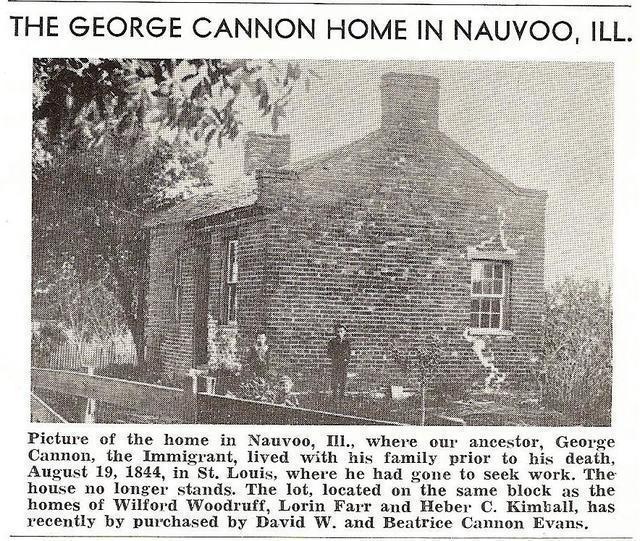
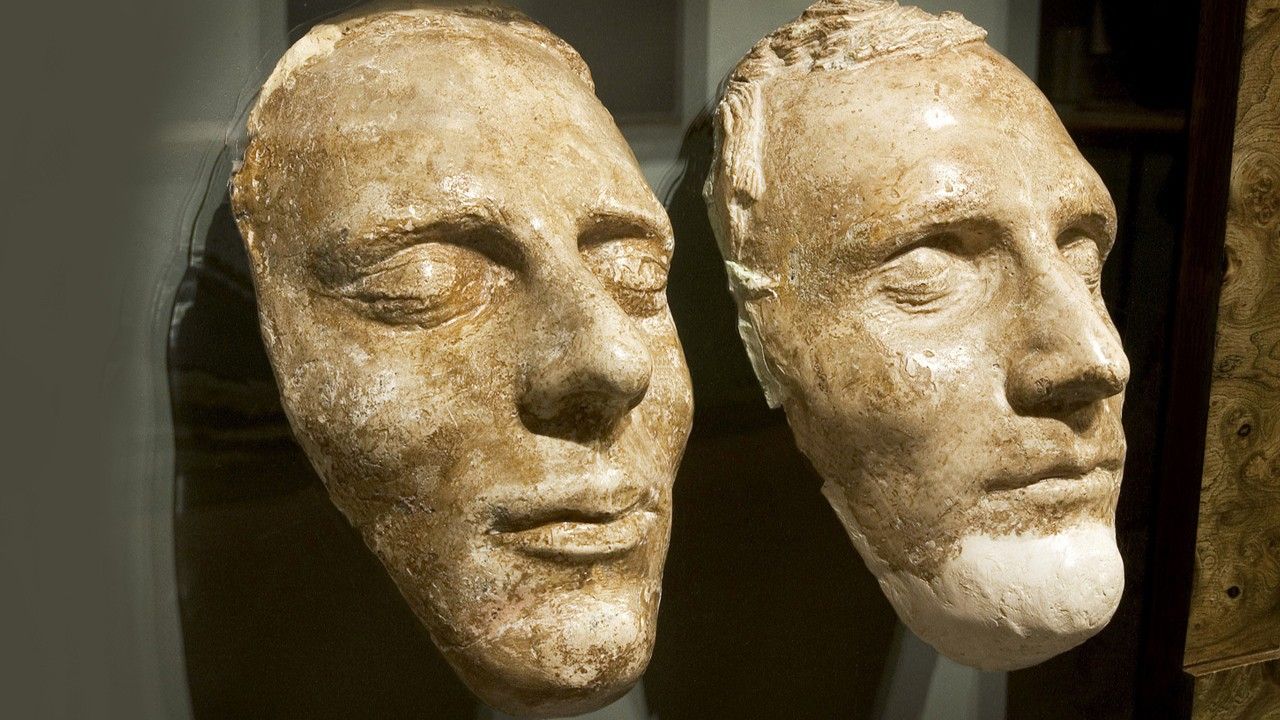
In June of 1844 Joseph and Hyrum Smith were killed by a mob in nearby Carthage jail. They were taken to George Cannon, the father, who was a furniture maker by trade and doubled as the local undertaker since he made coffins as well as cabinets. With the help of a few others, he washed the bodies and prepared them for their families to view. As part of the interment process George made death masks of Joseph and Hyrum that can be seen at the church history museum.
George left later that year to find work in St. Louis where he died. George Q., now 17 years old, went to live with his aunt and uncle the Taylors. In 1847 he travelled with the Taylors over the plains to the Salt Lake valley with the Joseph Horne company. The Hoagland family, including his future wife Elizabeth, were in the same wagon train.
The Cannon Family
The following biographies and other interesting material can be found at georgeqcannon.com:
This is a biography of Captain Cannon of the Isle of Man – George Q.’s grandfather.
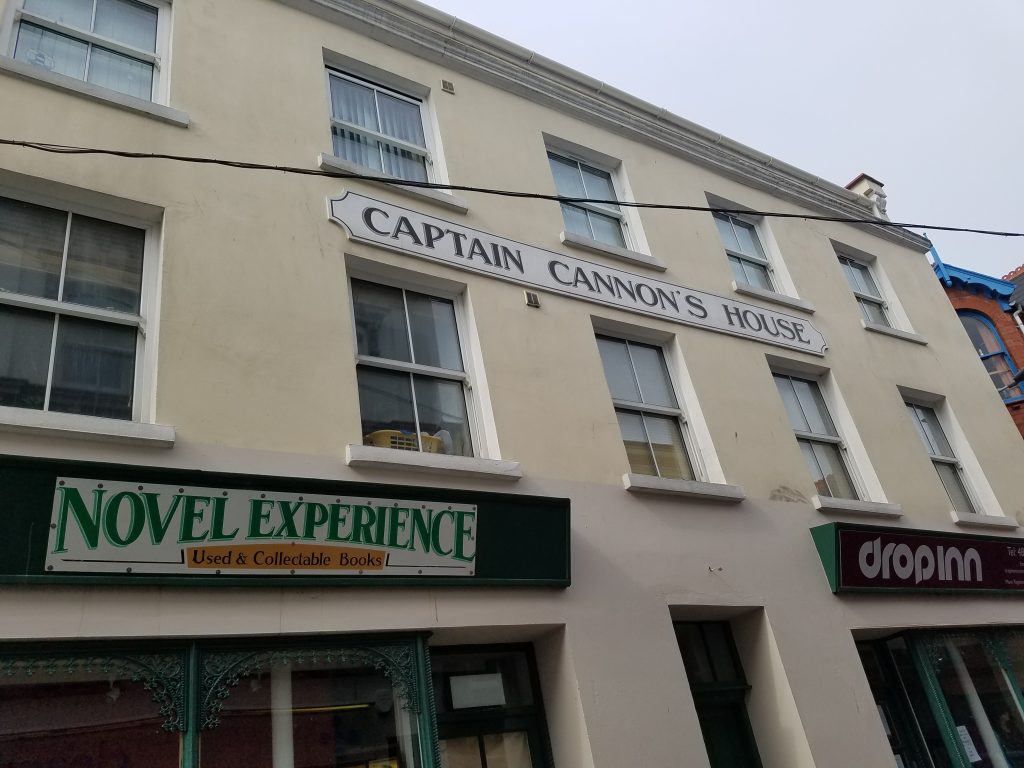
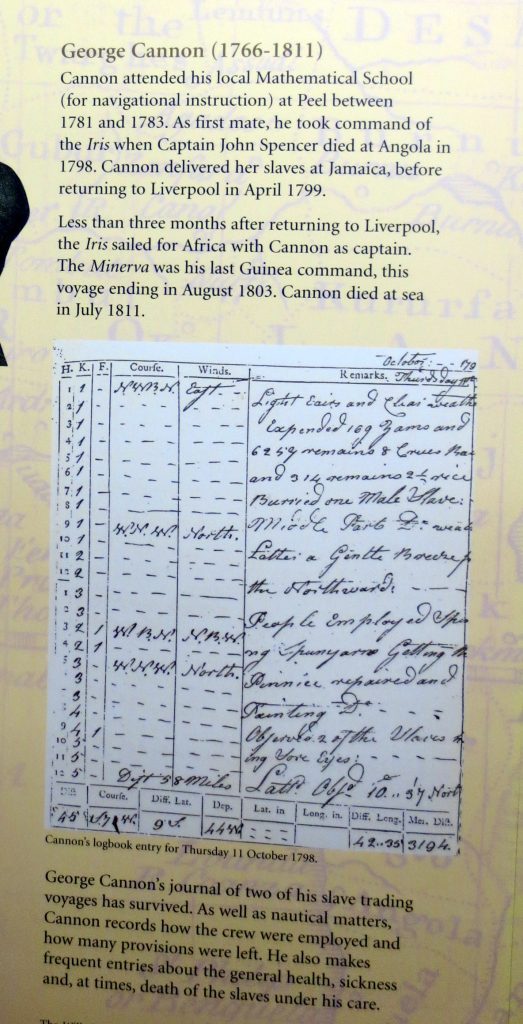
“George Cannon, the eldest son of Hugh and Eleanor Addy Cannon and the father of George Cannon the Immigrant, is the most picturesque and romantic figure in our history. He was born in Peel (Isle of Man) in May, 1766, and died at sea on board his own ship, July 19, 1811, being the victim of a mutiny which he was endeavoring to suppress among his crew, and which would have been suppressed without his death had his loyal subordinates been as prompt and courteous in meeting the outbreak in its incipiency as they were later severe in punishing the guilty participants.
George married, when he was 28 years old, Leonora Callister, who was his junior by nearly nine years, being herself born in November, 1775. Leonora was the youngest daughter of David Callister and Abigail Mylchreest (this surname is derived from an earlier “given” name, being contraction and corruption of an appellation meaning “the Manx). David’s father, John Callister, was seemingly quite a character. He is described as a merchant-cooper of Peel Town and was nicknamed Callister Creena,” that is, the wise or the sage Callister. His father, the earliest of the Callister of Kirk Patrick, who married Katharine Kermeen in 1686. The family was of much importance officially and commercially during many generations; for example, in the time of the last-named David, they enjoyed the unique privilege of burial within the church, instead of in the church-yard. Tradition says that the original source of the family was the estate of Gleneedle in Kirk Patrick parish, the first syllable of which, “Glen,” to say nothing of the Peel cooper’s thrift and wisdom, suggests Scotch descent and propensities.
It is likely that young George assisted his father Hugh in the fishery, and that with him he visited Liverpool, the busy English port where his seafaring instincts and his ambitions to engage in greater maritime adventures than his native Isle afforded would be inevitably be stimulated. Here he probably learned navigation and perhaps took an occasional smuggling trip. Certain it is that several years before his father’s death, the humble fisheries had lost any attraction they may have ever had and had become too tame for the bold son of Nell Addy, and we find him going in for smuggling on the large scale. As has been said, this so-called “free-trade” was at this time considered not only quite reputable but entirely patriotic also; and surely there were none better qualified to make life miserable and uneasy for the “hireling” revenue officials who were supposed to collect the taxes and customs than the hardy Manx mariners. They knew the coast and currents, the perils and the ports, the cliffs and caves, the havens and the headlands of their seagirt island as they knew the palms of their own hands. If the risks were great, so also were the rewards; and though profit was the underlying motive, yet there was nothing of the nature of downright piracy in the proceeding. When the English Parliament abandoned the harsh and discriminatory regulations which had given such impetus to the clandestine trade of the Islanders, the better-minded of the latter changed their course also; and the practices referred to were so diminished as to become thenceforth the exception rather than the rule.
Among those who thus came once more into good repute with the officials was our gallant Captain Cannon. Before making peace with them, however, he had led them many a merry chase, as had his confreres and compatriots of the tight little Island port. To this period belongs a noticeable architectural feature of so many of the residences of Peel. The town was in fact a storehouse magazine for foreign skippers to deposit vast quantities of East Indian and other goods that were then carried away by the smaller Manx vessels into Scotland, England, Wales, and Ireland, to the manifest detriment of the revenue. A writer of those times comments upon “the strange delight” the inhabitants took in “subterraneous dwellings”; there was hardly a building that had not “at least an equal number of rooms below ground as above it.” Captain Cannon’s house, still standing, was one thus constructed; and we may well imagine that in the days of his greatest contraband activity his underground apartments were well filled with curious and precious products from distant parts of the globe. Today are still to be seen the large cellar windows through which the casks of smuggled wine and bales of goods were lowered into their place of storage in his roomy basement; and we can easily picture him, on dark, tempestuous nights, when the well-equipped cutters of the revenue service would make for shelter, putting out unafraid to sea. The seamanship involved in such hazardous business was magnificent and worthy of the best of causes. The personal daring also was superb. It is related to one of these commanders, a contemporary of Caption Cannon’s, that, being surprised at anchor in harbor he promptly weighed anchor, bore down between the two cutters so close that he tossed his hat on one deck and his wig on the other, hoisted a cask on his maintop to show his occupation, and under a great spread of canvas showed his would-be captors a clean pair of heels.
Less dangerous, but hardly less illegal as judged by present-day opinion, was Captain Cannon’s next sea venture, a laconic account of which is given in an old log book, the property of George M. Cannon Jr., of Salt Lake City. This interesting record is inscribed on the fly-leaf in beautiful penmanship, “A Journal of a Voyage per Ship Iris from Liverpool to Bonney in Africa, commencing the 8th of June, 1798, by George Cannon.” A full page is set aside for each day’s entries, with a line ruled off for each hour of the day, together with columns for indicating the course sailed, the direction of the wind, the latitude and longitude as determined by observation, the distance sailed daily, and “remarks.” In the last column, of course, are found the incidents of interest, though most of the remarks pertain to the weather, the handling of the sails, the occupation of the crew during fair weather, and, as the voyage progressed, the rate at which the ship’s food supplies were being consumed. A few quotations are here given by way of illustration:
“First part of this 24 hours, light breezes and clear; at 8 p.m. Skerry lighthouse bore S.S.E., distance one league, and Holyhead S.S.W. dist. Above 4 leagues. At 10 a.m. five vessels in sight standing to the N.E. At Meridian (noon) was spoke by a frigate, three ships and two cutters in company. Supposed to be all King’s vessels. People (crew) employed in sundry necessaries; carpenter making shotlockers; gunner and crew (evidently the Iris was an armed vessel) making wads; cooper making deck pails,” etc.
On June 22, we find this reference, significant of the purpose of the Iris in going to Africa: “Cooper making tubs for the slaves.” About the middle of July land was sighted –one day a canoe came alongside — after which time the entries are few and irregular until the beginning of September, a portion of the interim being apparently devoted to taking on cargo, food and fresh water. Among the supplies secured in quantity appear to have been yams, rice and beans; of the former article the Captain must have loaded up with a great store, some 14,000 in number. That he kept an amusingly careful account of their consumption is proved and the number remaining on hand. Why he used them up at the rate of several hundred per day is explained in this adding “expended 200 yams, 13,945 remains, also beans and rice.” The log is silent as to how or for whom this vast human cargo was acquired. From the fact that Cape Palmas is mentioned in one entry not long before the reduction in his supply of yams began, the inference is reasonable that Captain Cannon took the slaves on board some time coast point in the Gulf of Guinea, a region still indicated in the geographies as the “slave coast”; and that the vessel was then pointed for the West Indies is proved in sight of Barbuda and St. Christopher Islands, which are in the Lesser Antilles group.
On this northwesterly journey across the Atlantic Captain Cannon more than once sighted ships that he expected to have to fight; and he reports making instant preparations to do so, although it does not appear that he at any time had occasion to engage in actual combat. He narrates some cases of sickness and two or three deaths among the slaves, but he seems to have taken such humane steps as were possible to provide for their health and welfare by issuing extra food rations and even liquor when the weather was cold. On many days they were reported as “in high spirits and very agreeable.” On the 1st of November he saw two suspicious looking vessels to leeward and “brought the to” until he could investigate them; and the next day he boarded one of two American ships out of New York bound for Philadelphia, which offered him “50 joes” to convey them into Kingston, Jamaica. They told him of having been taken by the French and some of their men being put to death, and they were short of provisions. He placed an officer and one man on each ship, and a few days later escorted them safely into port. At Jamaica or some other island in the near vicinity he appears to have unloaded his slave cargo, for in no subsequent entry do we find him referring to them or counting his yams.
In March of 1799, he gives the latitude and longitude of the North Key of Crooked Island (in the West Indies), “from which I take my departure.” On this trip, which we assume to be a return voyage to England, he appears to have been in the King’s service, for we find that his vessel was one of a fleet directed by a commodore, who frequently signaled the several captains of the squadron on board his frigate to receive instructions — a necessary precaution in view of the hostile relations then existing between England and France. The date of his arrival in England is not given, but it must have been during the early summer.
Another voyage, and probably again to Africa, brought him once more to the West Indies in 1800, through the entries in the journal are now so scattered and confused that it is difficult to trace from them the actual dates or places visited. However, on this second voyage of the ship Iris he reports “taking his departure” from Kingston, Jamaica, July 29, 1800. In fact, the journal would seem to include reference to even a third voyage, though the latter cannot be identified with any of the geographical points or localities referred to in connection with the other two. On this voyage there is a brief account of a long-continued storm of great intensity that caused the ship to leak badly, spoiled a large quantity of provisions, and played havoc with the rigging and cargo generally.
From this time on, Captain Cannon seems to have been regularly in the royal service, but we know little of his detailed activities. We have not been able even to ascertain the name of the ship on whose deck the mutineers killed him, or in what part of the watery world the tragedy was enacted. It is quite possible that in the course of his travels he came into some port in the United States, if not in the line of business or trade, at least in the hope of getting news to America, and of whose whereabouts the Captain would doubtless know more than anyone else. At all events it is evident that as much time as he had at his disposal between voyages was spent with his loved ones in the Isle of his birth. He had a large and growing family; and many of the children, who came along with tolerable regularity, were born while he was suffering the waves in distant seas.
The first born (Dec. 3, 1794) was George Cannon, who hitherto in this history has been, and will continue to be, designated “the Immigrant.” Next came Leonora, born October 6, 1796, who might with equal appropriateness be called “an Immigrant,” for she arrived in America long before her elder brother, and it was through her that he turned his face toward the western world. She was that great woman, the wife of John Taylor, both of them early converts to Mormonism, both intimate and steadfast friends of Joseph Smith, and the husband a later president of the church that the Prophet established. The third child was Thomas, born in 1799, who died in infancy; and followed him came Ann in 1800, who also died young. John was the next son, born in 1802. He went to Australia, located in Port Philip, became a part owner on shore in a small vessel, and wrote home glowing accounts of his prospects in an endeavor to persuade his eldest brother George to join him there; the wages of carpenters (this being George’s trade) he said were fourteen shillings a day! But George was skeptical. “Poor John,” he said, in writing to his sister, “is going to make a fortune directly; he always counts the chickens before they are hatched.” In 1804 a second Thomas was added to the family birth register, and he also died, in his nineteenth year. A daughter Elinor followed in 1806; she married Benjamin Tabner of Liverpool and had two children, after whose death and that of their father, as well as a second husband, she came to Utah and here passed away in 1885. The next addition to the family was a son, David, in 1810, after whose death in infancy another son, the youngest, also named David, was born in 1811, only two months before the death of his father at sea and therefore probably never having been seen by him. This son David was himself an immigrant, where he was living and doing well in Sydney in 1840, in which year his elder brother George received a letter from him.
The constant anxieties, the long periods of loneliness, and finally the cruel death of her husband under circumstances so sorrowful may naturally be supposed to have created in the mother of these children a hatred of the sea, and it is easy to believe that she pleaded successfully with her sons to avoid its service. At any rate, while several of her offspring undertook long journeys by water in search of new homes, it is significant that with the passing of Captain Cannon the lure of a seafaring life found no further favor in the hearts of his posterity.”

George Cannon “The Immigrant”
“George was born December 3, 1794 to George Cannon and Leonora Callister. He was only 16 years old when his father died. The family’s circumstances were suddenly altered. Captain Cannon was apparently prosperous, and his residence was accounted one of the interesting show places of the little town. Captain Cannon believed in scholastic training. Hence those of his children, who at the date of his death, were of an age to enjoy the advantages of scholastic training, received it. George and Leonora had this advantage.
But with the father’s death, a complete and sudden change took place in the family’s circumstances. While not left penniless, for they had their home and its valuable contents, as well as some vague and scattered shipping interests, they soon found themselves without a regular income. They rented their home, and the widow and her small children moved into a smaller house; while the two older ones, George and Leonora, went out to shift for themselves as well as help their mother. So George went to Liverpool, and Leonora crossed to England to act as a companion of a wealthy lady.
Ann Quayle to whom he married was the third of eleven children born to John Quayle (nicknamed “the Schemer”) and Ellinor Callister. Leonora Cannon and Ellinor Quayle were first cousins; and their children George and Ann were second cousins, except that their grandfathers were half instead of full brothers. Ann was born in Peel, August 26, 1798. She married George when she was 27 years old.
During the widow Cannon’s great bereavement, one of the first to extend sympathy and offer aid was her cousin Ellinor Quayle.
Ann Quayle and George were married in St. Thomas Church, Liverpool, on October 24, 1825. Before their marriage they made a remarkable agreement that if they weren’t able to have children they would give up their assured marital bliss in favor of a higher imperative duty, to bring children into the world to carry on the family name. Ann possessed the trait of thrift and careful management in temporal affairs. George had mastered the trade of carpenter and joiner (or cabinetmaker), and he was an industrious and clever workman. He earned good wages, but he was always lending his money. Very little of the money he lent came back to him. Besides he was contributing to the support of his widowed mother and her younger children. Therefore he didn’t have much money to set up housekeeping as a family man. His wife was very thrifty and took care of the money well. From the earliest recollection of the children it was understood that mother controlled the pursestrings, which was common practice in England during that time.
George was about 5 feet ten and a half inches in height, he weighed about 160 pounds. He had black hair, bluegray eyes and a fair complexion; erect, very energetic, sociable, goodnatured and with a keen sense of humor. He had literary ability as evidenced by his letters and diary. Ann appears to have been plump. Her height was about 5 feet 4 inches, her weight about 130 pounds; in complexion fair with black hair, eyes hazel with brown spots, marvelously full and expressive; in temperament inclined to be nervous, quick in all her movements, and tirelessly industrious. Both were excellent conversationalists. Both enjoyed reading, George was indulgent to the children, slow to wrath, always seeking an excuse to spare the rod, while Ann was swift to apply it, was strict in requiring obedience and looked upon too much leniency as a parental weakness. Yet no mother could be more truly affectionate and tender with her children, and no father more observant and exacting in his insistence upon correct moral conduct and filial behavior. She quickly forgave and with a more abundant display of love made up for her seeming sternness. His reproofs so clearly reflected the sorrow which his children’s misdeeds caused him that nothing more was needed to make them deeply repentant for having incurred his displeasure.
Both were of a religious and inquiring turn of mind, but neither could be satisfied with any of the sects or denominations. The mother made this a matter of prayer.
Their children were: George (he didn’t adopt the middle name Quayle until he was a grown man), born January 11, 1827; Mary Alice, born December 9, 1828; a son unnamed and dying soon after birth was born in the summer of 1830; Ann, born January 28, 1832; Angus Munn, born May 17, 1834; John Quayle, born March 25, 1836 (died at 3 years of age); David Henry, born April 23, 1838, Leonora, born September 11, 1840.
This is how Mormonism was brought into the Cannon household: Leonora had a friend who was going to Canada. She asked Leonora to go with her. Leonora declined to go, but she had a dream which directed her to go. So she went to Toronto, Canada in 1852. She married John Taylor. When he had first asked her to marry him she refused, but she again dreamed a dream which made her decide to marry him. They were converted to Mormonism by Parley P. Pratt. John Taylor went on a mission to England where he went to see his wife’s family. The first time he came he did not speak of religion, but after that first visit, Ann remarked “There goes a man of God.” He told them of the Gospel on his next visit. Before he left, most of his hearers had been fairly thrilled by his words, the wife especially being a firm believer from the beginning of his remarks, The husband was impressed, but not fully responsive. He determined to investigate fairly and devote as much time as possible reading the Book of Mormon until Brother Taylor returned. As he read the book his interest grew with every page, he could hardly lay it down. He read it all. When Elder Taylor returned he said, (the father said) he accepted it as of God. After being further instructed in Gospel principles, he and his wife were baptized February 11, 1840, exactly a month after Brother Taylor had set foot within their door. The children were baptized later; the three oldest at the same time, and the others as they reached the right age. They started saving money for their voyage to America to join the Saints. He paid the entire passage money for some of those who made the voyage with him, besides helping materially several others who did not have enough to make the voyage.
Various causes combined to delay the family’s departure from Liverpool during the year 1841. For one thing Leonora was still a babe in arms, and none too vigorous in health. Also it was felt that it would be desirable that some resident stalwarts remain on hand at the port of sailing to give assistance and encouragement to their fellow religionists who halted there temporarily before going on board ship. This was an appeal to duty which could not pass unheeded by a couple as devout and hospitable as George and Ann Cannon. Their relatives and friends used every possible argument to get them not to go. It was very plain that it was the wife and mother who, as time went on, became more impatient at the delay in setting forth on the journey. She was impressed that if another season passed before the family left that she would not be alive to urge the journey another year. She was afraid that her husband being brokenhearted would indefinitely defer goingmight indeed not go at all. Even if she should die before they completed their journey, she would know that they were with the people with whom they belonged. The thought that she might not survive the voyage was in fact more than a mere possibilityit was with her a certainty. She had a sure premonition that she should not live to reach America, and told her husband so. They all prayed, that God’s blessings would attend them in doing what was best, to leave or stay.
They left Liverpool on September 18, 1842. The mother Ann died at sea on October 28, 1842, and was buried in the sea. They reached St. Louis on the 11th of December, and here they spent the winter of 18421843. In April they made their way to Nauvoo by way of steamboat. Their trip of 7 months journey was finally ended and they reached Nauvoo. They knew Joseph Smith at first sight. He had come to meet the boat.
George needed a mother for his children. He married Mary Edwards White on February 24, 1844.
After Joseph and Hyrum were killed, George helped prepare the remains for burial. He made the coffins, and as he was one of the few in the city who had knowledge of the process, he took plaster casts of the faces and heads of the dead leaders as they lay in state. To George Cannon, therefore, and his versatility and skill, future generations have cause to be grateful for a correct outline of the heads and features of the devoted brothers who sealed their testimony with their blood.
George felt compelled to go to St. Louis for employment. Without warning he died on August 19, 1844, a victim of sunstroke. His place of burial is unknown.”
What follows is a description of the Cannon family’s sea crossing from England to America:
“Liverpool, September 3, 1842 – Gave notice to my employer that I was leaving his employ that day. He had previous to this offered to give me five shilling a week more wages…Finding that I was determined by the help of God to go, he acknowledged that my testimony and his own observation had led him to conclusions which made him tremble , and he begged of me to write to him when I got to Nauvoo the truth.
Now the petty trials commence in every shape. All our friends know that we will bitterly repent leaving England and a constant employ. We can get nothing for our furniture – our friends who are so anxious about us will buy none of it, not even the clock or drawers which belonged to the family. My wife’s brother did not come to see us off. Well, this shows how deeply they have our happiness in view!
…On Sunday, the 18th (Sept. 1842), we all left Liverpool in good spirits, and nothing caused me so much regret as leaving so many of the Saints behind, anxious to go but without the means to do so.
We are now launched on the bosom of the mighty deep, and sea-sickness has made the passengers for the most part very ill. My dear Ann is dreadfully affected with this nauseous sickness, perhaps more so on account of her pregnancy. In how many ways and shapes are we tried! Not a morsel of food or drink will remain on her stomach – the moment she lifts her head she is sick almost to death. Yet I have never heard one complaint from her on her own account, but regret at not being able to assist me in the care of the children. Her stomach seems to have changed its functions, and this is the tenth day without anything passing through her.
And how am I all this time! Well in body, but if depending on my own strength I should be in despair. But thanks be to our Heavenly Father, He has removed a fear from my mind which has preyed on it for years. Many years since I dreamed a dream which time or circumstance has never been able entirely to remove. I was impressed with a conviction that my wife should die while in a state of pregnancy. This was before I thought of marrying. Many would think this proceeded from imbecility of mind or superstition; but my dreams (those I mean which made a deep impression on my memory) have been fulfilled so plainly that I never could doubt but that God sent them for some good purpose. I have never seen my wife pregnant without this fear of her death, and always felt thankful to God in a twofold sense when this critical time was past. She was aware of this feeling of mine, and it was a trial of our faith to cross the sea while she was in this state…
While racking my mind and considering and devising what more I could do for my Ann – I had given her consecrated oil, caster oil, pills, salt water, etc., had the hands of the Elders laid on her, still she continued in the same state and I feared that inflammation would take place…Leonora and David have had no sickness and are less trouble than I expected; but George, Mary Alice, Anny and Angus have all been very sick, particularly George and Anny.
This is Tuesday, the 4th of October – a delightful day; the wind is fair and the vessel going about five knots. I am sitting in the stern of the vessel. On each side of the deck are laid some spars, on which and on the vessel’s side – not too high up – are seated men, women and children, the younger children scrambling about the deck, while my poor old woman is lying on the hatch under the boat still very ill and unable to hold her head up for any length of time. This is the only drawback to my pleasure, all the rest are well.
Saturday, 8th of October – Up to this time nothing of consequence occurred on board. My poor Ann still continues very sick and is getting weaker every day….
During the whole of this time my dear Ann continues very ill and is still getting weaker…We had performed the first half of our voyage in less than three weeks, but from that time it has been a series of calms with a light breeze, sometimes in our face. My heart used to die or sink within me along with the breeze. ‘Are we far from New Orleans that I may get some grapes and wine?” was my dear Ann’s constant inquiry, when I came down off the deck, as she is too weak to be taken on deck herself. I endeavored to speak words of comfort to her, while I had no prospect of her ever seeing the land of Joseph in this life. Dear Ann, the next wine thou shalt get will be pure in the Kingdom of Heaven! She talked of her death as of a sleep, told me not to lament her, that if she lived to reach the Mississippi she must be buried on land, if not, the great deep must receive her poor body that is shrunk to a mere skeleton.
I will not attempt to describe the night in particular which I have passed while watching by the side of one of the best wives that ever man was blest with – to see the grim tyrant approaching slowly but steadily to his victim; yet with all her sufferings no complaint ever escaped her, but the words, ‘Dear George, what am I to do?’ These words are never to be forgotten by me while I have memory. O God, how mysterious are Thy ways! Teach me resignation to Thy will!
This morning, Friday 28th of October, she fell asleep without a sigh, and in the performance of what she considered the commands of God, at half past four o’clock, and was buried in that element which needed no consecration, it never being cursed, in Lat. 24.37 N., Long. 69.50 W., at five o’clock in the afternoon of the same day.
How soon our plans and prospects are changed! Although in expectation of bearing many things which are not of a pleasant nature – privation or poverty we agreed to share with the Saints, but we are tried in a more tender part, and were it not for our helpless children’s sake I should like to repose under the peaceful blue waters with her who shared my every joy and sorrow. Heavenly Father keep me from repining! But seeing other people enjoying the society of those they love, my heart sickens and I long to be at rest with my dear wife.”
George Q. Cannon

“George Quayle Cannon was born in Liverpool, England, 11 January 1827, the oldest child of George and Ann Quayle Cannon. George’s parents and ancestors were originally from the Isle of Man. The Cannons’ association with the Mormon Church occurred when his aunt, Leonora Cannon, with her husband and future president of the church, John Taylor, was baptized by Parley P. Pratt in 1836. Four years later, John Taylor, while on a mission in England, converted the Cannon family including thirteen year old George. The family left Liverpool two years later and sailed for America. During their voyage, George’s mother died, leaving six children and a widowed husband to reach Nauvoo, Illinois, without her. Two years later, George’s father also died.
Arriving in Nauvoo in the spring of 1843, George lived with John and Leonara Taylor’s family. Soon thereafter, George began work as a printer’s apprentice for his uncle in the publishing office of the Times and Seasons and the Nauvoo Neighbor. Following the assassinations of Joseph and Hyrum Smith, George watched over the affairs of the printing business while his uncle recovered from wounds he received at the Carthage Jail.
George Cannon accompanied the Taylors to Winter Quarters in 1846, and arrived in the Salt Lake Valley in October 1847. Two years later, he accompanied Charles C. Rich on a church mission to the California gold mines and then continued on to the Sandwich Islands with nine other missionaries.
Cannon quickly mastered the Hawaiian language and proselytized for four years among the island peoples. Upon his return to Utah, he was sent to California on another missionto assist Parley P. Pratt in a newspaper venture. When George reached San Francisco, Pratt was preparing to return to Utah, but stopped long enough to set Cannon apart to preside over the California and Oregon missions. While in California, George published the first edition of the Book of Mormon in the Hawaiian language. He also established the Western Standard, a newspaper intended to defend the Mormon Church and spread its gospel. When word reached California of a possible war in Utah, Cannon returned to Salt Lake City and was given responsibility of the Deseret News publishing enterprise and commissioned an adjutant general in the Nauvoo Legion.
In September 1858 Cannon was called to preside over the Eastern States Mission; his duties included directing westward immigration and quelling falsehoods concerning Utah and the Mormons. The following year, he was sustained an apostle to fill the vacancy created by the murder of Parley P. Pratt.
Greater responsibilities followed when Cannon was sent to preside over the European Mission. His specific duties were to direct emigration and supervise the printing of the Millennial Star. However, within a few months he was notified that he had been elected as one of Utah Territory’s two congressional representatives and was immediately needed in Washington, D.C., to assist in Utah’s 1862 bid for statehood. At the adjournment of the 1862 congressional session, he returned to Europe for two years to continue his assignment as presiding authority.
Cannon returned to Utah in the fall of 1864 and became the private secretary to Brigham Young. At this time he stated that, with the exception of nine months, he had been absent from home for fifteen years in service to the church. Under the tutelage of President Young, Cannon became well acquainted with all aspects of church affairs, and, recognizing the need for appropriate reading material for the youth, established the Juvenile Instructor magazine in 1866. The following year he was called as general superintendent of the Deseret Sunday School Union, a position he held until his death. Later that year, he was appointed to oversee the Deseret News. One of his first decisions as president and editor was to renovate the semiweekly into a daily newspaper named the Deseret Evening News. He left the paper in 1872 when he was elected a Utah delegate to Congress.
Cannon’s sincerity, gentlemanly demeanor, and intuitive diplomatic talents made him an effective statesman. For ten years he successfully defended Utah’s interests in Washington, D.C., until his seat was declared vacant by the enactment of the Edmunds Act, which terminated numerous constitutional rights for Utah’s polygamists. The ensuing years were some of the most difficult for the Cannon family. In 1885 George was forced to live in seclusion due to the raids attempting to arrest Mormon polygamists. His five wives and thirtytwo children were often watched by marshals and deputies. In September 1888 he surrendered himself to local authorities and served nearly six months in Utah’s federal penitentiary for cohabitation.
In 1880, three years after the death of Brigham Young, the First Presidency was reorganized with John Taylor as president and George Q. Cannon as first counselor. Cannon remained first counselor in the two subsequent administrations of Wilford Woodruff and Lorenzo Snow. During those years, his entrepreneurial aptitude became manifest. Before his death in 1901, at the age of seventy four, Cannon had been associated with more than sixty Utah commercial, mercantile, and industrial businesses. His devotion to his family, his church, and his religion are an important legacy he left to the world.”
Biography written by Joseph A. Cannon and Rick Fish
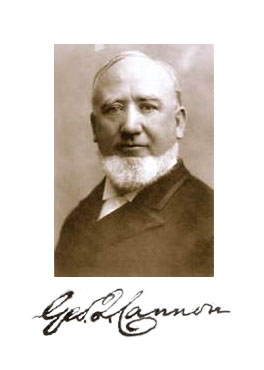

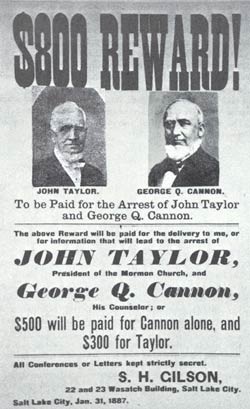
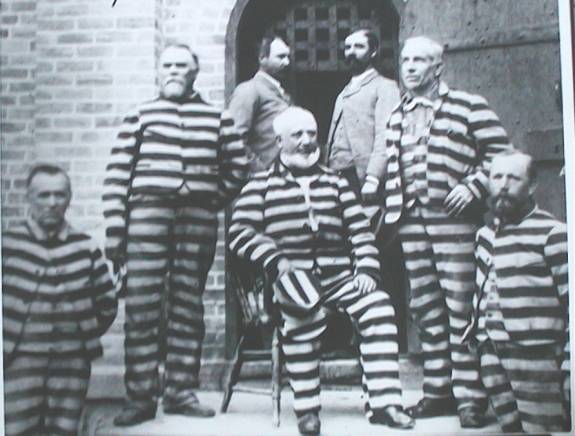
The image below is of the George Q. Cannon Farm Houses and Wives. Our ancestor is Elizabeth Hoagland shown second from the right. This property is south of the Salt Lake City downtown area on the Jordan River on the West side of 1000 West St., immediately South of California Ave. (1330 South). The city has developed around it, but some of the houses still stand. The house on the far right of this picture is still there, (on the southwest corner of the modern day intersection) Elizabeth’s is not, and some of the buildings on the left side of this picture are still standing.

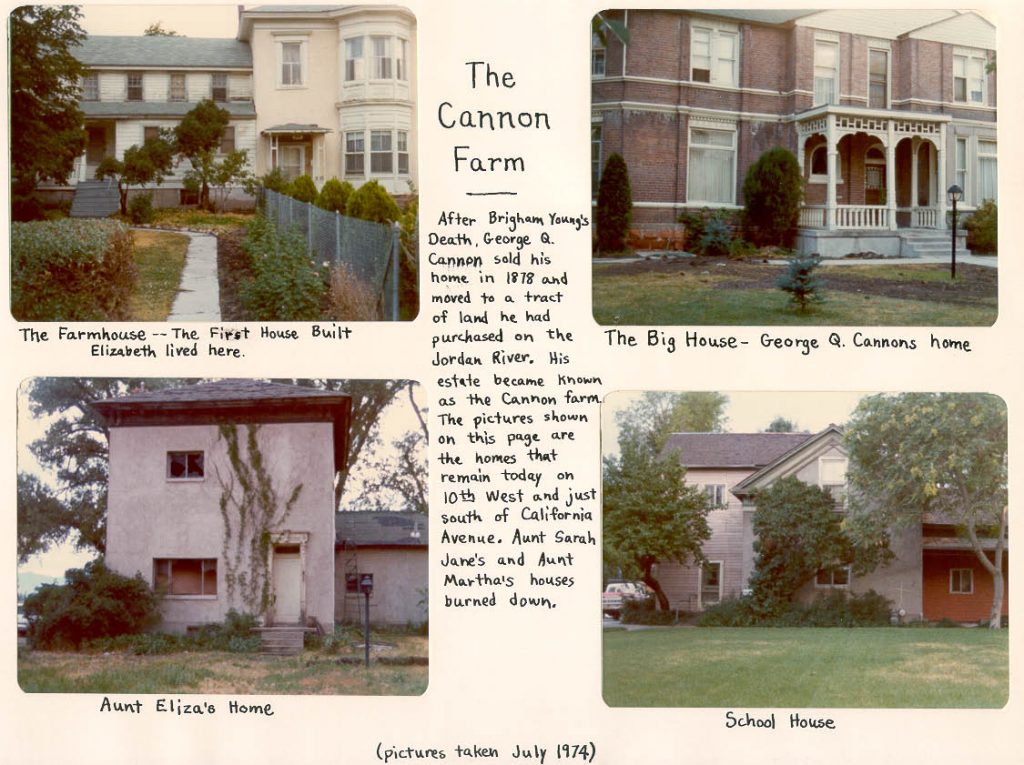
The link below will allow you to download a story of the Cannon farm written by Margaret Cannon Clayton who lived there as a child. Our great grandmother Andrew (Louise B. Cannon) also grew up on the farm.

Photos of George Q. Cannon at various ages with his plural fami
Abraham, Margaret, and Elizabeth Hoagland
Abraham Hoagland was born on March 24, 1797, in Hillsborough Township, New Jersey. He apprenticed as a blacksmith and moved to Michigan with his wife Margaret and their children, including our ancestor Elizabeth who later married George Q. Cannon. In Michigan he became a prosperous blacksmith and farmer and helped settle present-day Royal Oak. While in Michigan, he joined the Church of Jesus Christ of Latter-Day Saints in 1841.
In 1843, he moved his family to Nauvoo, Illinois, where Joseph Smith ordained him an elder. After Joseph Smith’s death and the abandonment of Nauvoo by the saints the Hoaglands crossed the Mississippi and made their way across Iowa to winter quarters.
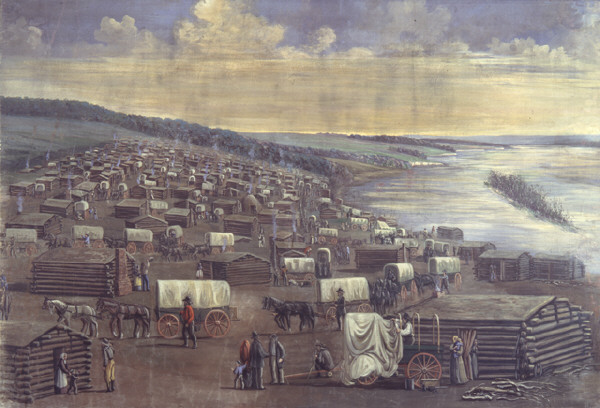
Winter Quarters was an encampment formed by approximately 2,500 members of The Church of Jesus Christ of Latter-day Saints as they waited during the winter of 1846–47 for better conditions for their trek westward. Orson Pratt and Wilford Woodruff ordained Abraham a bishop in Winter Quarters, Nebraska after the saints were driven from Nauvoo. In 1946 The Taylors and George Q. Cannon also spent the winter there preparing to travel westward in the Joseph Horne company to cross the plains.
Below are images from the Logbook of the Horne Company showing the entries for our ancestors. The log books are preserved in the church history library


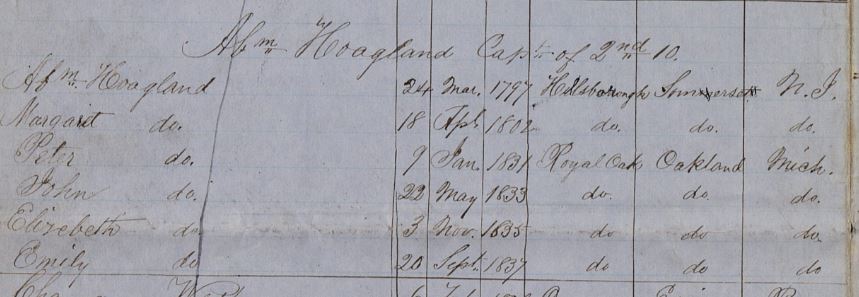
Elizabeth Hoagland

Elizabeth Hoagland, daughter of Abraham Lucas Hoagland and Margaret Quick was born on 03 Nov 1835 in Royal Oak, Michigan. She died on 25 Jan 1882 in Salt Lake City, Utah.
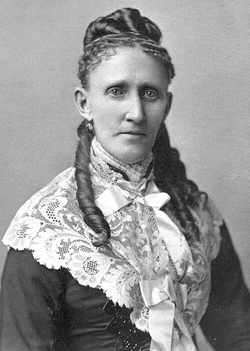
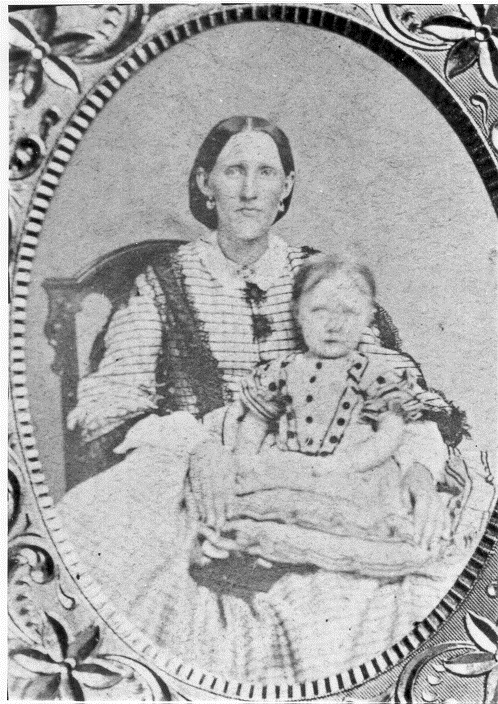
Elizabeth Hoagland Cannon Story by Janath Russell Cannon
“First wife and childhood sweetheart of George Q. Cannon. This photograph was taken in Denmark in the early 1860’s while George Q. was presiding over the European Mission.
Elizabeth Hoagland was only eleven in 1846 when her family fled across the frozen Mississippi from mob-threatened Nauvoo and made their way to Winter Quarters. But Elizabeth was large for her age and proved to be a great help to her parents in the trek across the plains, walking much of the way to lighten the load for the oxen and at other times helping her father drive. Apostle John Taylor was in charge of their company, and with him was his nineteen- year- old nephew, George Q. Cannon. Young George often found occasion to help Elizabeth with her tasks along the way, and a firm friendship soon developed. In later years, recalling the songs and dances around the campfire at night, the games they played, the joy and laughter rather than the hardships.
Abraham Hoagland, Elizabeth’s father, was a blacksmith and could shoe his own horses and repair his own wagon if necessary. Both he and his wife, Margaret Quick, were of sturdy Dutch descent; and both had already pioneered a new settlement in Royal Oaks, Michigan. It was here, November 3, 1835, that Elizabeth was born, the third child in a family of three sons and three daughters. It was here that the family accepted the Gospel from the Mormon elders before moving to Nauvoo. In Nauvoo Abraham became a bishop, a position he held with honor the rest of his life, presiding over one of the four wards at Winter Quarters, assisting Presiding Bishop Edward Hunter in the early pioneer days, and becoming the first bishop of the Fourteenth Ward in Salt Lake City.
John Taylor’s company, the first to follow the original pioneers, arrived in the Salt Lake Valley in September, 1847. Bishop Hoagland built a commodious abode and log house for his family and planted the first honey locust trees in the valley. The friendship that had begun on the trip west continued between Elizabeth and George Q. Cannon. But in 1849 George was called with some other young men to go to California and engage in gold mining for the Church. In a letter written years later, he reminded Elizabeth of her reply to his question, “I am only called for a year to California. Would you prefer that I went for perhaps three years to France?” She replied, “I would rather you went to save souls that to find gold, even though the time be longer.” The answer was prophetic, for a missionary call took George from California to Hawaii; and he was gone five years in all, fulfilling the first of his many missions for the Church. During the waiting years, Elizabeth taught a school in the 14th Ward and helped her mother in the many homely domestic arts necessary to a pioneer family.
Soon after his return George Q. Cannon and Elizabeth Hoagland were married, on December 11, 1854, the bridegroom dressed in an ill-fitting borrowed suit. They were poor in worldly goods, but rich in youth, courage, and devotion to the Gospel. Their wedding trip was a perilous journey across the Nevada desert en route to assist Elder Charles C. Rich in the presidency of the California Mission and to establish a newspaper, The Western Standard, with headquarters in San Francisco. Their two-year mission was full of enough hardship and sorrow to require all their courage. There was little money for the upkeep of the mission home, where two of the newspaper printers also lived. Elizabeth’s resourcefulness and frugality were taxed to their limit. Their eagerly- awaited first child, George Q. Jr., lived only a few weeks; and the second, John Q., was only a baby when the call came to return to Utah to meet the invasion of Buchanan’s army. Leaving her husband behind to sell the printing plant and close up the mission affairs, Elizabeth set out with her brother-in-law, David H. Cannon, her baby, and the body of little George Q. in a metal casket in the back of the wagon; for she was unwilling to leave him buried in a far-away land.
Within a few months of their arrival in Salt Lake, George Q. and his family, which now included a second wife, Sarah Jenne, moved south to Fillmore, taking along the Deseret News printing press. As he returned northward from the move, George Q. was intercepted at Payson by a messenger from President Young calling him on a mission to the Eastern States, asking him to leave immediately. He, Elizabeth, and baby John Q. left within an hour. A few weeks later, on March 12, 1859, Elizabeth’s third son, Abraham H., was born.
When her husband returned from the two-year mission, Elizabeth rejoiced to have him ordained an apostle as a member of the Council of the Twelve. But the longed-for home of her own was not to be. In a few weeks, she left with her husband for England, where he had been called to preside over the European Mission and edit The Millenial Star.
At Brigham Young’s suggestion the two little boys were left behind in Sarah Jane’s care. Two other children were born to Elizabeth in England: Georgianna, her first daughter, and a son, George Hoagland. In addition to caring for them and the demands of the mission home, Elizabeth traveled extensively throughout England and the continent with her husband on his official duties and was much loved by the Saints and Elders.
In 1863 Elizabeth and her children, including ten-year-old Rosina, an adopted English orphan, left England for home with a party of Mormon emigrants. Again her husband remained behind, this time to await his successor in the mission presidency. The journey home was long and full of heartbreak for Elizabeth. The party was detained six weeks at Florence, Nebraska by an epidemic of whooping cough. Little Georgianna died on the plains at Sweetwater, and once again the mother journeyed home with the body of a child she refused to bury in a strange place. Soon after their arrival home the little boy George H. also succumbed to the dread disease.
In later years, Elizabeth lost two other children, Lillian and Elizabeth, who died in infancy. She bore her sorrows with her customary fortitude. President Joseph F. Smith, who knew her well, spoke of her as a woman of patience, faithful endurance and unquestionable integrity.
Elizabeth had little chance to enjoy the quiet home life she desired, for her husband’s active career in the Church and as territorial delegate to Congress took her on many journeys with him. When Congress was in session, she made a temporary home in Washington that was a haven of comfort for her husband and children, as well as a place for official entertaining. When at last it seemed as though she might enjoy some years of unmolested home life, her health began to fail.
At the time of her death, January 25, 1882, her two oldest sons, John Q. and Abram, were married and performing missions in foreign lands. She had told John as he left for his mission, “My son, this is our last farewell; you will never see me again in life. God bless you.” To her husband, who was in Washington trying desperately to prevent the passage of the Edmunds Bill, she sent the following telegram: “Remain at your post. God can raise me up, if it is His will, in answer to your prayers there as well as if you were here. All is being done for me that can be done.” Later that day she had her four youngest children brought to her bedside. Commending little Sylvester to the care of Mary Alice, she kissed them all and blessed them before she died.
This is another biography written by Annie Wells Cannon:
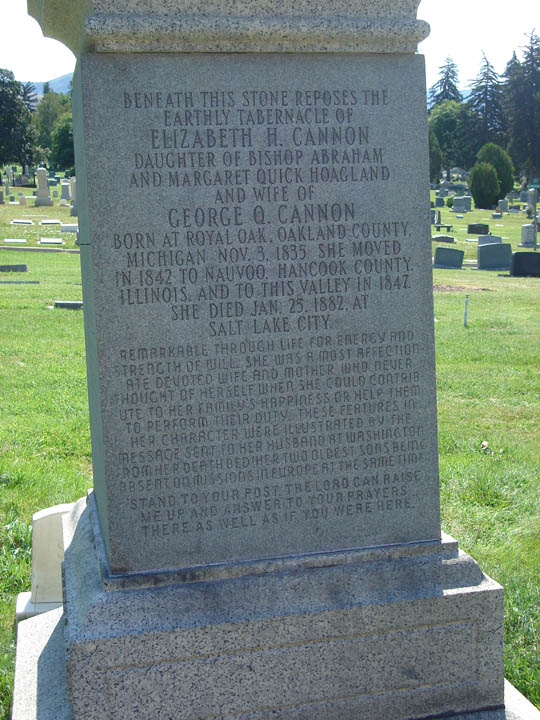
Abraham and Margaret Hoagland
Abraham Lucas Hoagland, son of Lucas Hoagland and Mary Bunn was born on 24 Mar 1797 in Hillsborough, Somerset Co., New Jersey. He died on 15 Feb 1872 in Salt Lake City, Utah. He married Margaret Quick, daughter of James Quick and Maria Hagerman on 24 Nov 1825.
Margaret Quick, daughter of James Quick and Maria Hagerman was born on 18 Apr 1802 in South Branch, Somerset, New Jersey. She died on 01 Nov 1871 in Salt Lake City, Utah.
The Hoaglands descended from some of the earliest Dutch and French colonists of New Amsterdam. Jacobus Quick from New Jersey is one of our family’s Revolutionary War soldiers. Uncle Dick Andrew used his descendance from Jacobus to become a member of the Sons of the American Revolution.
After the war the Quicks and Hoaglands moved west to take advantage of new land opening up for settlement.
Abraham and Margaret moved to Royal Oak, Oakland Co., Michigan, where they bought property in 1825. Margaret’s brother, Dennis Quick, also moved there and bought property at the same time. Property records indicate that they moved there from Somerset Co., N.J. They appear on the 1830 U.S. Census in Royal Oak.
The Mormon Church was organized in 1830. Missionaries from the church traveled through the Royal Oak area and met the Hoagland’s. They were baptized into the church in 1841.
The family joined the Saints in Nauvoo and crossed the plains in the second group and were part of the 1847 pioneer settlement.


Abraham Hoagland and Margaret Quick
This biography can be found at georgeqcannon.com/GQC_Docs.htm
“I have a story concerning that which has come down through the generations of Royal Oak residents. In the story Abraham was talking to his neighbors about his newfound Mormon religion and is quoted as saying while sitting at dinner “that he was just as sure of going to heaven as he was of eating the meat he was there in the act of putting in his mouth.” The strength of that belief and commitment was shown throughout the rest of his life.
In 1843, he took his family and moved to Nauvoo, Illinois, where the Latter-day Saints were gathering. He was ordained an Elder in the church by the Prophet Joseph Smith. On June 27, 1844, Joseph Smith and his brother, Hyrum Smith, were killed by a mob. The Saints were then persecuted and driven out of Nauvoo. Abraham and his family suffered all these persecutions along with the Saints.
They left Nauvoo in 1846 in the general exodus of the Latter-day Saints. They stopped in Winter Quarters, Nebraska, which was a stopping point for the Saints between Nauvoo and Utah. In Winter Quarters, Abraham was ordained a Bishop by Brigham Young, the new leader of the Saints. Abraham was responsible for the welfare, both spiritual and temporal, of a group (called a ward) of Saints. (There were around 4,000 Saints divided into 22 wards.)

In 1847, he and his family migrated by wagon train to the Great Salt Lake Valley where he helped found Salt Lake City. Abraham built a log and mud cabin in the “Old Fort” on what is now known as Pioneer Square (Pioneer Park), but early moved to his allotted acre and a half on the corner of Second South and First West Street, where he built a more commodious log and adobe house Around this corner Bishop Hoagland, with the help of his children, planted Honey Locust seeds from which grew, with the years, large and beautiful shade trees. These were the first trees of that kind in the valley.
When the people moved out of the forts and established Salt Lake City in 1849, Abraham served as a counselor to a bishop. In 1851, he was ordained bishop of a ward again. Until his death in 1872, he served as bishop of the Fourteenth Ward in Salt Lake City. He was considered a kind and affectionate leader and was greatly loved. He never faltered in his testimony of the truthfulness of the church to which he devoted all the days of his life in service. He has many descendants who today are active members of the Church of Jesus Christ of Latter-day Saints.”
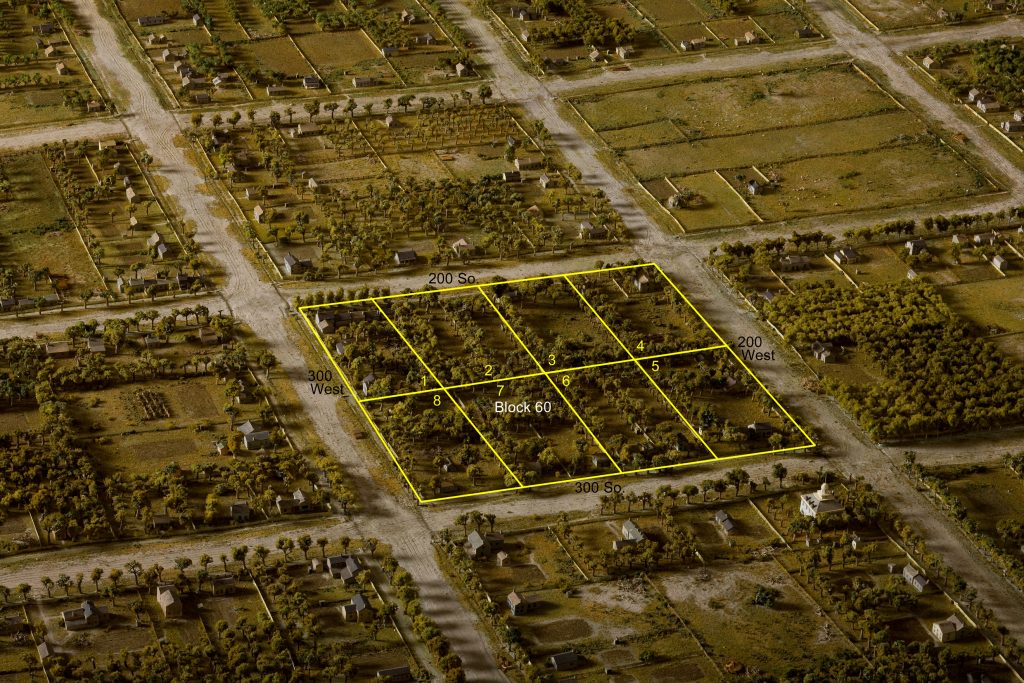
The link below is to a written summary of Abraham Hoagland’s journal where he writes about his experiences including crossing the plains and the early years in the Salt Lake Valley .
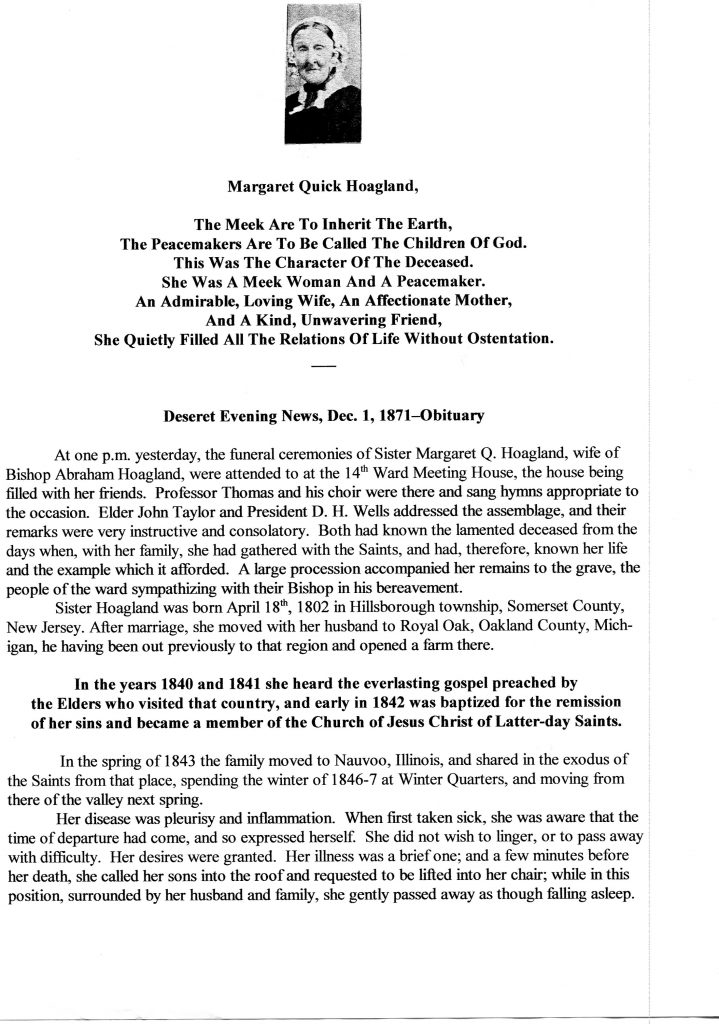
Daniel Hamner Wells
Daniel Hamner Wells was born in Trenton, New York, a member of the sixth generation of his family in America. His original immigrant ancestor was Thomas Welles (1590–1659), who arrived in Massachusetts in 1635 and was the only man in Connecticut’s history to hold all four top offices: governor, deputy governor, treasurer, and secretary. Wells was also a descendant of John Webster, fifth governor of Connecticut. A few years after the death of his father in 1826, Daniel H. Wells left New York with his mother Catherine Chapin Wells and his younger sister Catherine C. Wells and moved to Illinois.
In 1834, before he was even legally of age, Daniel bought his first eighty-four acres in Hancock County, eventual site of Nauvoo. He was elected constable and justice of the peace as soon as he came of age. In 1837, Daniel married Eliza Robison, the daughter of an evangelical preacher and widower who had courted and married his mother. Crops were bountiful, the markets rewarding, and Daniel began to sell land to newcomers like the Mormons. Daniel’s future in Nauvoo seemed promising. He accepted a post on the city council and associated with the Mormon leaders as a nonmember colleague. In August 1846, after armed forces attacked the city, he asked Almon W. Babbitt, one of the trustees of the Church selling property in Nauvoo, to baptize him a Latter-day Saint.
Because Eliza never shared his faith, he settled her with relatives in Burlington, Iowa, and left behind his property, his public position, and his wife and son to meet the Saints in Winter Quarters in June 1848, where he became Brigham Young’s aide-de-camp for the journey west.
Daniel Hamner Wells
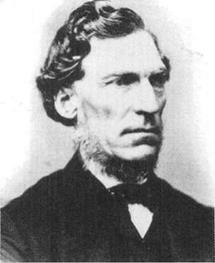
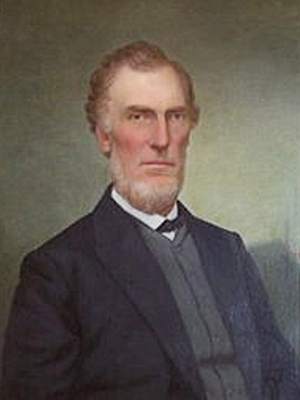
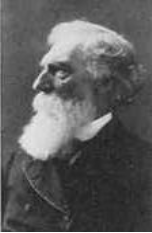

The six plural wives are shown in one group photo, in the front row, from left to right, Lydia, Emmeline (Our Ancestor) and Martha; and in the back row, Hannah, Louisa and Susan.


There are several good biographies available. Recently one of Daniels descendants published the biography “Defender: The life of Daniel H. Wells”
Daniel Hanmer Wells was born in Trenton, Oneida County, New York, October 27, 1814 the only son of Daniel Wells by his second wife, Catherine Chapin. He had one full sister, Catherine Chapin Wells, and five half sisters. When Daniel was twelve years old, his father died and the care of his mother and young sisters fell upon him. He was large in stature and strong of limb, capable of doing a man’s work but received a boy’s wage on a neighboring farm. When his father’s estate was settled, Daniel and his sister received a small legacy and they decided that with their money the family could improve their living conditions by moving westward.
His mother consented, and they migrated to Marietta, Ohio, where they remained during one winter and where Daniel taught school. In the spring, they journeyed farther west into northern Illinois, settling at a little place called Commerce. Taking up the virgin land, Daniel cleared it of timber, built a small house, farmed, planted orchards and otherwise developed and beautified their new home on the borders of the western wilderness. His mother remarried, and in 1835 Daniel married Eliza Robison. A year later a son was born to them whom they named Albert. Daniel accumulated large tracts of land and had every prospect of wealth, position and prosperity.
Even before attaining his majority, he entered upon an official career, being first elected constable and later justice of the peace. At this time he acquired the title of esquire Wells’ by which he was familiarly and reverently known throughout the long years of his life. He was an officer in the first military organization of Hancock County. In politics he was a staunch Whig, the forerunner of the Republican Party, into which he merged and remained to the end of his days.
Brilliant seemed his prospects, but in 1839, when Squire Wells was twenty-five years of age, the outcast Mormons from Missouri came up the Mississippi River to northern Illinois. With his innate sense of justice and his characteristic generosity, Squire Wells at once extended to these refugees a hearty welcome, and platting his land into city lots he let them have them at their own terms. Thus arose part of the beautiful city of Nauvoo. On a bluff above the village, where he owned eighty acres of land, the Nauvoo Temple was built. When Nauvoo City was organized and charters granted by the Legislature of Illinois to the City, the University and the Nauvoo Legion, Daniel was elected alderman and member of the city council, a regent of the University and commissary general on the staff of the major general. He was not at this time a member of the Mormon Church, but the Prophet Joseph Smith often conferred with him about the affairs of his people. As justice of the peace, he had sometimes to hear cases brought against the Prophet and Mormon leaders, and was thus able to give them a just and fair hearing and help to liberate them from the hands of their enemies.
Two years after the martyrdom of the Prophet and Patriarch at Carthage, Daniel became a member of the Church of Jesus Christ of Latter-day Saints by baptism, though long before he had become convinced of the divinity of the mission of Joseph Smith, and had gained a testimony of its truth. There were good and sufficient reasons, however, for his holding back; first, he could better serve his friends through his influence and authority by not joining the Church. There were personal reasons also. His wife did not accept the teachings of the Church and was strongly opposed to his leanings thereto. At the time of the expulsion of the Saints from Nauvoo, his soul was wrung with anguish for he realized the injustice and cruelty of it all and longed to be with them. His wife refused, however, to leave Illinois and he remained until after all promises of the state authorities were broken and the City of Nauvoo was besieged by military and mob forces. He then took up arms in defense of this outraged people and cast worldly and selfish thoughts aside for the sake of a righteous faith. The sorrow of this trial is better told in his own words written in a letter to President Brigham Young at this time:
“I see no prospect short of a complete sacrifice of everything I hold dear on earth as well as in a pecuniary point of view as the kindlier affections of the human heart. Please to remember me before the Lord, that I may be sustained through the dark days and at least one ray of light may beam into my soul to cheer me on my way. Think not that I am despairing or desponding, for although my soul is bowed down under a great weight of affliction, yet my faith is placed upon the Lord of Hosts, and ‘come weal, come woe’ I will be with you by the first of April, sooner if possible.”

He left Nauvoo broken-hearted, separating thus from his wife and little son and all his earthly possessions save his traveling outfit. After the battle and fire of Nauvoo, he left Illinois and traveled day and night over the Iowa prairie to overtake the advancing companies of emigrants, in order to send back relief teams and supplies for the homeless refugees, the last remnant expelled from Nauvoo. Daniel joined the Saints at Winter Quarters, and in 1848 was aide-de-camp to President Brigham Young in the second journey of the great pioneer to the Rocky Mountains. He reached Salt Lake City in the fall of that year.
Wells was given two lots in pioneer Salt Lake City. They were on the north west corner of 4th south and State street and on the opposite corner of the block to the south east. They are adjacent to the block allotted for the city county building. For the first two years Daniel and family lived on tone of those lots in the covered wagon they crossed the plains in. Brigham Young was using Daniel is an assistant in several colony building enterprises and wanted him to be closer to his property. He let Daniel and family use two small adobe buildings on President Young’s lots on south Temple and State Street.
In 1855 Ezra T. Benson had completed a large house on the south east corner of South Temple and Main St. directly across from Temple Square. Benson was called to move overseas in a church leadership position and Brigham Young arranged for Wells to buy the newly completed house. (pictured below).Wells and family moved into this house in 1855.
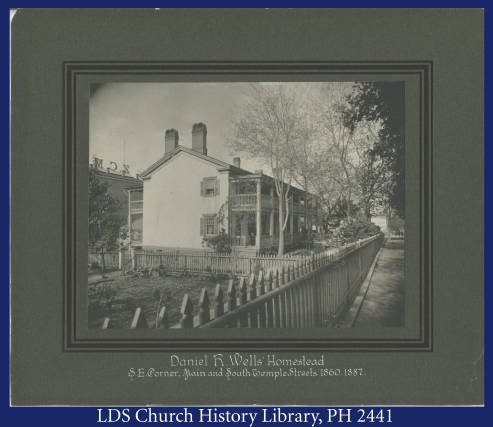
Daniel served in the first Territorial Legislature and nearly all succeeding sessions until and including that of 1882. He was a member of every Constitutional Convention except the last, and was influential in drawing up the prospective constitutions for statehood. For a period of ten years, 1866 to 1876, Squire Wells was mayor of Salt Lake City.

As a state builder, he was active in every progressive enterprise. When the Deseret Telegraph was built he was one of the promoters and was vice-president of the company. In 1848 he was appointed superintendent of public works, a semi-religious position, and acted in that capacity at the laying of the cornerstone of the Salt Lake Temple. He superintended the building of the Council House in which the courts of Utah were originally held. He was one of the first to develop the coal mines of Summit County, and for many years owned and operated lumber mills in Big Cottonwood Canyon. The manufacture of nails was successfully carried on by him, and it was his factory which furnished the nails for the building of the Salt Lake Theatre. In 1872 he established the Salt Lake City Gas Works and for years held the heavy burden of what was then an un-remunerative enterprise, sacrificing nearly all of his vast holdings for public benefit.
His military career was doubtless the most stirring and colorful of all the incidents of his life, and as General Wells he is best known among the non-Mormon element of the community. From the battle of Nauvoo when, on his white charger he was a conspicuous target for the enemy, down to the disbanding of the Nauvoo Legion, as the state militia was called, his life was full of thrilling and dangerous events. He commanded the forces that opposed the entrance into the valley of Johnston’s army, known as the Utah War, a strategy so staged that no blood was spilled, and yet victory and a peaceful settlement were attained.
Daniel took to the field in person during the Indian troubles in Utah, Sanpete and Sevier counties. He was elected under the territorial militia law, Lieutenant General of the militia, and every year held encampments and trained the men for service, until the disbanding of the militia by governmental order in the early ’80’s.
Daniel was an ardent lover and patron of the drama and all educational institutions. It was he who offered the dedicatory prayer for the Salt Lake Theatre, invoking divine protection on every article of construction, as well as the productions and the performers. He was one of the first regents and was second chancellor of the state university then known as the University of Deseret, from 1869 to 1872. It was under his chancellorship and due to his influence, that this school assumed a university standing, virtually the beginning of its career.
However, that for which he made his great sacrifice was his unfaltering faith and testimony of Mormonism, and as a Church leader and high priest his character looms above all other activities. In the Church he held the offices of elder, high priest and apostle. On the 4th of January, 1857, he became one of the First Presidency, chosen to fill the vacancy caused by the death of Jedediah M. Grant, second counselor to President Brigham Young. Twice he presided over the European Mission, 1864–1865 and again in 1884–1887. From 1868 until 1884 he presided in the Endowment House. He attended the dedicatory services of all the temples built before his death, and traveled among the people throughout the valleys of the mountains, locating settlements, organizing stakes and wards and exhorting the people in the work of the Church.
It was on such a journey, going to encourage and assist the settlers in Arizona, that a strange mishap befell him. While crossing the Colorado River at Lee’s Ferry, the boat containing his traveling wagon and outfit, with himself and a number of his party, capsized into the rushing waters. Daniel was a poor swimmer but he struck out for the shore and reached it. His escape was most miraculous, for one of the best swimmers in the party, Bishop Roundy, was drowned.
He was appointed president of the Manti Temple on his return from his second European mission and this appointment made a very happy ’rounding out’ of a busy and active life. He loved the work and was familiar with it in all of its phases, and the peaceful atmosphere of the House of God was most congenial to him in his declining years. He was still laboring there when his last illness came upon him in the form of grippe, which, after his return to his own family fireside, turned to pneumonia. He passed away March 24, 1891.
Like other Church leaders of his day he had a large patriarchal family, seven wives and many children, all of whom adored him, for he was generous to a fault, patient, kind, and tender. He surrounded his family with every comfort, and gave his children the best advantages of education and accomplishment to be had. They had great freedom for pleasure and association and at the same time gentle guidance in paths of rectitude, and before them always the example of a man who was, in all respects, a consistent Latter-day Saint.
Daniel H. Wells lived a long unblemished life and his posterity is proud of their heritage. His brethren with whom he labored and who knew him best paid him many fine tributes, some of which would be quite appropriate to quote. President Lund: “His discourses were brief, but gems full of wisdom.” President George Q. Cannon: “If there was one characteristic he possessed more than another it was his fidelity. I do not suppose that a more perfect man, so far as physical bravery is concerned, was to be found anywhere. His unflinching valor, not only physical, but also that higher and rarer quality, moral courage.” Moses Thatcher: “His integrity was beyond question, his sagacity admirable, his devotion to the truth sublime, his simplicity unadulterated, and his friendship steadfast as the everlasting hills.”
He was a great student, an ardent reader, a man of strong intellect. He did not read superficially, however, neither did he adopt the views of writers unless his own judgment approved of that which he read, as he was an independent thinker and possessed literary ability to a marked degree.
Late in life and under financial duress Daniel Wells sold his large home on South Temple and bought separate cottages for his wives. Daniel lived with our ancestor Emmeline in a house at 327 Second Avenue and died there.
A Story from one of Daniel Wells’ descendants – “My great-great grandfather was a man by the name of Daniel H. Wells, a tall, gangly lawyer in Illinois at the same time Lincoln practiced. Wells later joined the Mormon Church and moved to Utah, but it was in Illinois that Lincoln and Wells crossed paths, and Daniel H. Wells declared that Abraham Lincoln was a dead man. “I promised myself,” Wells said to the future president, “that if I ever met a man uglier than I was, that I would shoot him on sight.” To which Lincoln reportedly replied, “Then shoot me now! Because if I’m uglier than you, I don’t want to live.” This story was recounted to me by my uncle after my cousin noted how much I looked like Daniel H. Wells.”
Daniel Wells and George Q. Cannon became close confidants of Brigham Young. George spent his young adulthood travelling the world doing the work of the church. Daniel was held closer to home helping Brigham build Utah directing public works, leading the military, and running various businesses. The engraving below shows the most influential leaders of the Mormon church in 1877. Daniel is pictured top right and George Q. bottom center:
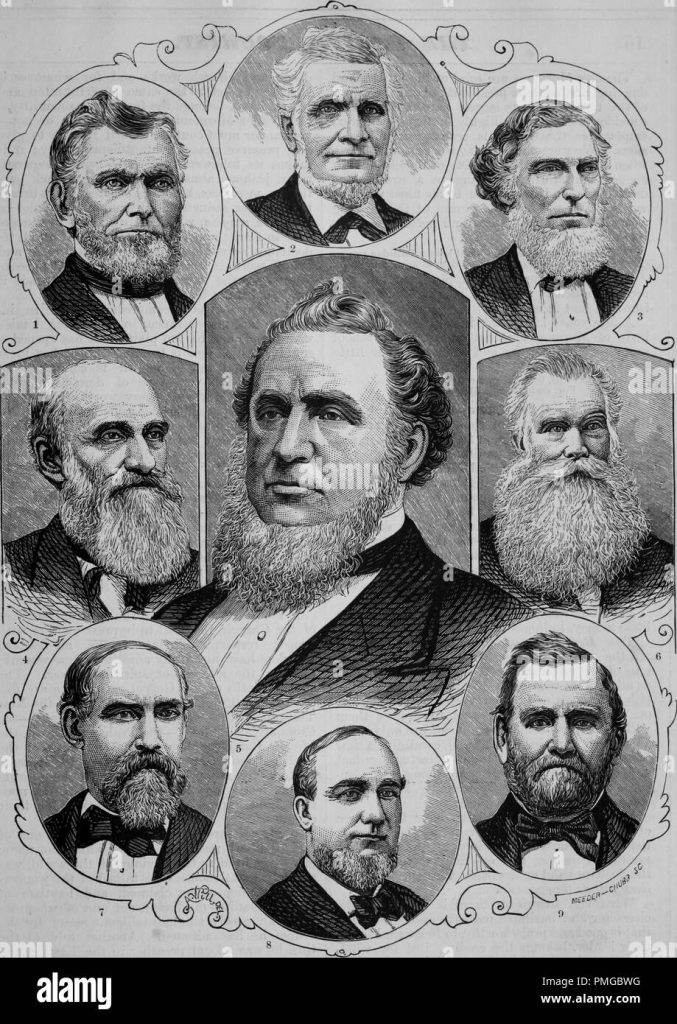
Emmeline Blanche Woodward
Emmeline B. Woodruff
Emmeline Blanche Woodward was born on February 29, 1828, in Petersham, Massachusetts. She was the seventh child of David and Diadama Hare Woodward. Her father died when she was four years old. She would later claim that her widowed mother inspired her to be a women’s rights advocate. When her mother got remarried to Samuel Clark Jr., the Woodward family moved to North New Salem, Massachusetts. There, Emmeline spent ten years of her childhood. Religion heavily influenced her first years of life; her family attended the local village church per New England tradition. As a child, she wrote poems and stories, which she shared with her friends. She often enjoyed being in nature. Woodward was very intelligent and began studying in public school until she enrolled in the New Salem Academy. She graduated from the Academy at the age of fourteen.
The revivalist movement disrupted New Salem’s previous religious unity, and Woodward’s community was split among different denominations. Following her mother, siblings, and a few friends, Woodward joined The Church of Jesus Christ of Latter-day Saints on March 1, 1842. After her baptism, she returned to the Academy and continued her schooling; she did not attend church meetings for her first year of membership. When she applied to become a teacher, discrimination against her new faith proved to be a challenge. Nevertheless, she persevered and taught school briefly in Orange, Massachusetts, before her first marriage at the age of fifteen.
She married 15-year-old James Harris, also a new church member, on July 19, 1843, in Vernon, Vermont. This marriage proved to be difficult for the young Emmeline; her mother-in-law disapproved of her, and she was unprepared for married life. Later, she wrote that she had been too emotional to make such an important decision and regretted marrying at such a young age. Life for Emmeline (now Harris) only became more difficult when she, along with the Harris family and a group of other New England Latter-day Saints, left for the Mormon settlement of Nauvoo, Illinois, in 1844. After a time, her mother- and father-in-law left the church and Nauvoo, so she and James were left alone. She gave birth to a son, Eugene Henri, on September 1, 1844. Unfortunately, Harris had been sick with “ague” during her pregnancy, and at six weeks old, her infant son became sick as well and did not survive. In addition to battling her own illness and the sorrow of losing her son, Emmeline said goodbye to her husband, who left to find work in St. Louis. He asked her to leave Nauvoo to live with his parents once more, but she refused. James Harris died as a sailor in the Indian Ocean and never returned to his wife.
The young Emmeline Harris returned to teaching. Through his children’s attending her school, Harris met and later married Newel K. Whitney on February 24, 1845, under the Mormon practice of plural marriage. Emmeline Whitney admired her new husband and felt much safer as his wife. She left Nauvoo in 1846 and, along with the large Whitney family, left Winter Quarters, Nebraska, for Utah Territory in 1848. They traveled with the Heber C. Kimball company at the invitation of then-church president Brigham Young. During the journey, Whitney grew close to her sister-wives. She became friends with Elizabeth Ann Whitney in particular. During the journey west, Wells began recording her life experiences in the first of what would become 47 journals (copies of her journals are available online). She was pregnant when the company reached the Salt Lake Valley on October 8, 1848. Her first daughter, Isabel “Belle” Whitney, was born in the back of the same wagon that had carried her mother across the country; Emmeline later recounted, “our poor wagons and tents were the only homes we had.” After a Whitney family home was constructed, her second daughter, Melvina Whitney, was born on August 18, 1850. Unfortunately, this good news was followed in short order by her second husband’s unexpected death. Emmeline Whitney deeply mourned his passing. By age 22, she had been widowed twice.[6]: 95–97 Shortly before his death, Newel Whitney had told her that she would prove to be “a tremendous influence in the building of the kingdom in the west.”
Emmeline B. Wells
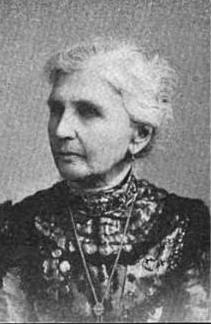
Emmeline B. Wells (1828-1921)
Unshakeable in her commitment to plural marriage, Emmeline Wells was a leading figure in Mormon politics and in the women’s suffrage movement who helped close the gap of misunderstanding that separated Mormons and non-Mormon America for more than fifty years.
Wells was born into a somewhat intellectual New Hampshire family in 1828. Her father died when she was four, and she was raised by her mother and numerous older siblings. But this fairly conventional New England upbringing took an unusual turn in 1841 when Wells returned home from boarding school to find that her mother had converted to Mormonism. Wells soon converted as well, and the next year, at the age of fifteen, she was married to the son of the leader of the local Mormon church. In less than a year, the young couple left New England for the Mormon enclave at Nauvoo, Illinois, arriving there several months before Mormon founder Joseph Smith was murdered by an anti-Mormon mob.
For Wells, personal tragedy marked the tumult following Smith’s murder. Her month-old son died in November 1844, and soon thereafter her husband, whose parents had parted ways with the church, abandoned her. Nevertheless, Emmeline and her faith in Mormonism survived. Three months later she accepted the Mormon’s only recently revealed doctrine of plural marriage and entered into plural marriage with a Mormon elder in a ceremony presided over by Brigham Young.
Wells was part of the Mormon exodus from Illinois, traveling overland across the prairies, and arrived in Utah in 1848. In 1852, two years after the death of her second husband, she became the seventh wife of Daniel Wells, a leading member of the Mormon community and a general of the Mormon militia. After Emmeline bore her fifth and last child in 1862, she turned her efforts toward politics and public service. She began writing for the Mormon women’s magazine The Woman’s Exponent, becoming its editor in 1877. With the encouragement of her second husband’s first wife, she also became very active in the Relief Society, a charitable group run by Mormon women.
Through The Woman’s Exponent, Wells became an articulate spokesperson for women’s rights and a defender of plural marriage. Drawing on her own experience, she argued against the view, widespread in the non-Mormon world, that women’s rights and plural marriage were irreconcilable opposites, the one based in sexual freedom and the other in sexual bondage. For Wells, women’s rights and plural marriage were instead complementary, since in plural marriage a woman found the personal freedom and independence to exercise her rights as a member of society. And she gained a more detached perspective on the male part of society than a woman whose social standing rested on a single man.
Wells put her advocacy of women’s rights into practice by waging a campaign for women’s suffrage in Utah, which met with success in 1870 when the Mormon legislature, fearful of the growing number of predominantly male non-Mormons arriving in the territory, gave women the right to vote. (The legislature still prevented women from holding office, however, and blocked Wells’ efforts to become Salt Lake City’s treasurer.) In 1887, Congress stripped Utah women of their voting rights as part of a protracted effort to deprive the Mormon Church of its political power and force an end to the practice of plural marriage. In response, Wells and other women formed the Woman Suffrage Association of Utah, a group devoted to returning the vote to Utah women. They were finally successful in 1896 when Utah was admitted to statehood with a female suffrage clause in its constitution.
Wells played an important part in the process of mutual understanding that eventually brought the Mormon community into the mainstream of a non-Mormon, frequently anti-Mormon, American society. To Mormons, her prominence within national organization such as the Woman’s Republican League and the National Suffrage Association was evidence that Americans were not universally hostile. To other Americans, Wells’ national stature and friendship with such luminaries as Susan B. Anthony, Elizabeth Cady Stanton and Carrie Chapman Catt made it more difficult to reflexively think of Mormons as anti-social deviants. The Mormon hierarchy appreciated her service. In 1912 she was awarded an honorary degree from Brigham Young University, and in 1928, seven years after her death, a marble bust of her likeness was placed in Utah’s capital building. 8
Emmeline Blanche Woodward Harris Whitney Wells (pronounced em-ma-leen) (February 29, 1828 – April 25, 1921) was an American journalist, editor, poet, women’s rights advocate and diarist. She served as the fifth general president of the Relief Society of The Church of Jesus Christ of Latter-day Saints (LDS Church) from 1910 until her death.
Emmeline Blanche Woodward was born in 1828 in Petersham, Massachusetts, the daughter of David and Deiadama Hare Woodward. Her father died when Emmeline was four years old. Precocious, energetic and intelligent, she graduated at age fourteen from the New Salem Academy. She taught school briefly before her first marriage at the age of fifteen.
Woodward joined the Church of Jesus Christ of Latter-day Saints (Mormons) in 1842. She married 16 year old James Harris, also a new member of the church, the following year. In 1844, the young couple, his parents, and other Latter Day Saints from their region migrated to the headquarters of the Church, Nauvoo, Illinois. After the death of their infant son Eugene Henri, Harris left Nauvoo looking for work and never returned.
The young Emmeline Harris returned to teaching. Through his children in her school, she met and later married Newel K. Whitney, a significantly older man, under the Mormon practice of plural marriage. Emmeline Whitney left Nauvoo in 1846, and traveled to Utah Territory with the extended Whitney family in 1848. At this time, she began maintaining a personal journal. Wells would continue writing in her diaries (forty-six journals are known) until 1920, shortly before her death. On the first page of volume 1, dated Friday, February 27, 1846, she recorded:
“Mrs. Whitney, Sarah Ann, and myself crossed the river to go the encampment of the Saints. We crossed the river a part of the way on foot, and then went on the encampment about 1 mile beyond…. We repaired immediately to Mr. H. C. Kimball’s tent, took supper, and slept for the first time on the ground. There was a snowstorm without, yet all was peace and harmony within.” Whitney’s death in 1850 left her with two young daughters, whom she supported by again teaching school in Salt Lake City. She remained primarily responsible for supporting herself and her children for the rest of her life.
Emmeline Whitney approached Daniel H. Wells, a friend of her late husband and a prominent civic leader, about marriage. In 1852, she became Daniel Well’s seventh wife, bearing him three daughters. Their early marriage was distant, as Daniel Wells was heavily involved in civic and church duties and had six other families. However, later in their lives, the couple became fond and loving companions.
Wells was the editor of Utah’s Woman’s Exponent, a semi-monthly periodical established in 1872 for Mormon women. Wells was a contributor to the magazine from its inception, but for its first five years of existence the editor was Louisa Greene Richards. Wells became the associate editor in 1875 at the time Cornelia H. Horn ended her term as business manager. Wells was the editor from 1877 until the publication ceased in 1914. As editor she wrote all the editorials, many of the articles and most biographical sketches contained in the publication. Near the end of her tenure as editor Wells had the assistance of her daughter Annie Wells Cannon as assistant editor.
Wells was a delegate to the 1882 Utah State Constitutional Convention, where she served on the Committee on education and the committee on schedule and elections.
Wells also wrote numerous short stories and poems, most published. She later compiled her poetry into a single volume, Musings and Memories. In 1912 she became the first Utah woman to receive an honorary degree, in literature, awarded her by Brigham Young University. A bust of Wells, inscribed “A Fine Soul Who Served Us”, is found in the rotunda of the Utah State Capitol. The bust was funded through the efforts of women’s groups in Utah, including the feminist community, LDS women’s groups, and women’s groups from other church organizations. Wells is, to date, the only woman so honored.
Women’s suffrage:
Wells became an early advocate of women’s rights, writing under the name “Blanche Beechwood” for the Woman’s Exponent. “I believe in women, especially thinking women,” she wrote. Wells was chief editor of the Women’s Exponent newspaper for 37 years, beginning in 1877. In addition to reporting news of the Mormon Women’s Relief Society, she used the publication to support woman suffrage and educational and economic opportunities for women. As editor, she became known for her executive talents and her superb memory.
Wells was active in the national women’s suffrage movement, where she served as liaison between Mormon and non-Mormon women and fielded hostile criticism associated with the practice of polygamy. On the national level, she was closely associated with both Elizabeth Cady Stanton and Susan B. Anthony. For nearly thirty years she represented Utah women in the National Woman Suffrage Association and the National and International Councils of Women. Beginning in 1879, with her attendance at a suffrage convention in Washington, D.C., Wells acted as a lobbyist for Utah interests. She met congressmen and presidents and addressed the issues of polygamy and women’s suffrage from the Utah woman’s point of view. Wells was also involved in the ultimately successful effort to restore suffrage to Utah women in the 1896 Utah state constitution. In 1899, Wells was invited by the International Council of Women to speak in London as a representative of the United States.
Beginning in 1879, Wells advocated that women be granted the right to hold office in Utah Territory. In 1878, she had turned down a nomination for Salt Lake County Treasurer from the People’s Party because women were not eligible to hold office in the territory. In 1879 she, along with Sarah M. Kimball, urged Governor George Emery to support women holding office, which he declined, and in 1880 she was the leading force involved in convincing Charles W. Penrose to introduce legislation to grant women the ability to hold office.
In 1893 Wells was elected president of the Utah Territorial Women’s Suffrage Association. After Utah gained statehood, Wells did run for election. In a much publicized election, the 66-year-old Wells stood as one of several “at Large” Republican candidates for state senator from Salt Lake County. Martha Hughes Cannon, a physician and former employee at the Women’s Exponent, was one of five Democrats running for the office. On November 3, 1896, Cannon defeated the field, and became the first woman ever elected as a state senator in the United States.
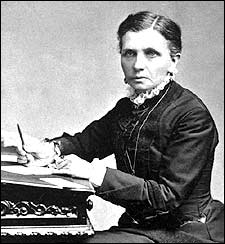
Church service
For several years Wells served as the corresponding secretary of the LDS Relief Society.
Wells was selected as general secretary for the Relief Society by President Eliza R. Snow and served for twenty-two years in the position under succeeding presidents. In her youth in Nauvoo, Wells briefly knew the LDS Prophet Joseph Smith, Jr.. In 1905, as Relief Society Secretary, she wrote the following to the young women of the Church:
| “ | In the Prophet Joseph Smith, I believed I recognized the great spiritual power that brought joy and comfort to the Saints. . . .He was beyond my comprehension. The power of God rested upon him to such a degree that on many occasions he seemed transfigured. His expression was mild and almost childlike in repose; and when addressing the people, who loved him it seemed to adoration, the glory of his countenance was beyond description. At other times the great power of his manner, more than of his voice (which was sublimely eloquent to me) seemed to shake the place on which we stood and penetrate the inmost soul of his hearers, and I am sure that then they would have laid down their lives to defend him. I always listened spell-bound to his every utterance—the chosen of God in this last dispensation. (“Young Woman’s Journal”, Dec. 1905) | ” |
Wells was appointed by Brigham Young in 1876 to head a Church based grain-saving program, and managed the church wide program until the beginning of World War I. In 1919, Wells received a personal visit in her Salt Lake City home from US President Woodrow Wilson who presented her a commendation for selling the collected wheat to the government for the war effort.
Wells was called as the Relief Society organization’s general president in 1910 at the age of 82. She served for eleven years, administering service issues related to the world war and dealing with issues relating to growth and administrative expansion. To her sorrow, the Relief Society Board declined to continue their support of the Women’s Exponent, and the publication closed in 1914. Ill health led her to be released in 1921, at the age of 93. Wells died three weeks later and was buried at the Salt Lake City Cemetery. Wells’s first counselor Clarissa S. Williams succeeded her as Relief Society general president.
In 1928 Mrs. Wells was honored, when a statue of her was unveiled in the State Capitol and accepted on behalf of the State of Utah by Governor Dern. The rotunda had been decorated for the occasion with numerous flowers and plants. The bust was the gift of the women of Utah and has a permanent place in the north west niche of the rotunda.
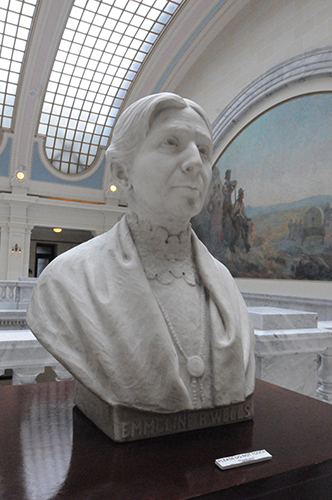
Wells authored the text of the Latter-day Saint hymn Our Mountain Home So Dear, which is hymn #33 in the 1985 English-language LDS Church hymnal.
Below are links to a copy of a poem that Emmeline wrote and to another biography:
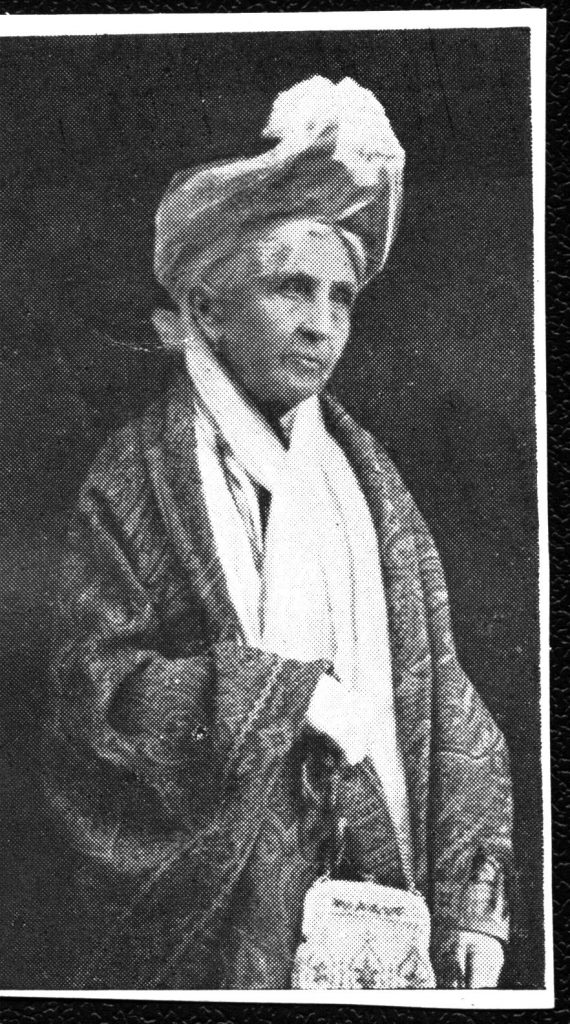
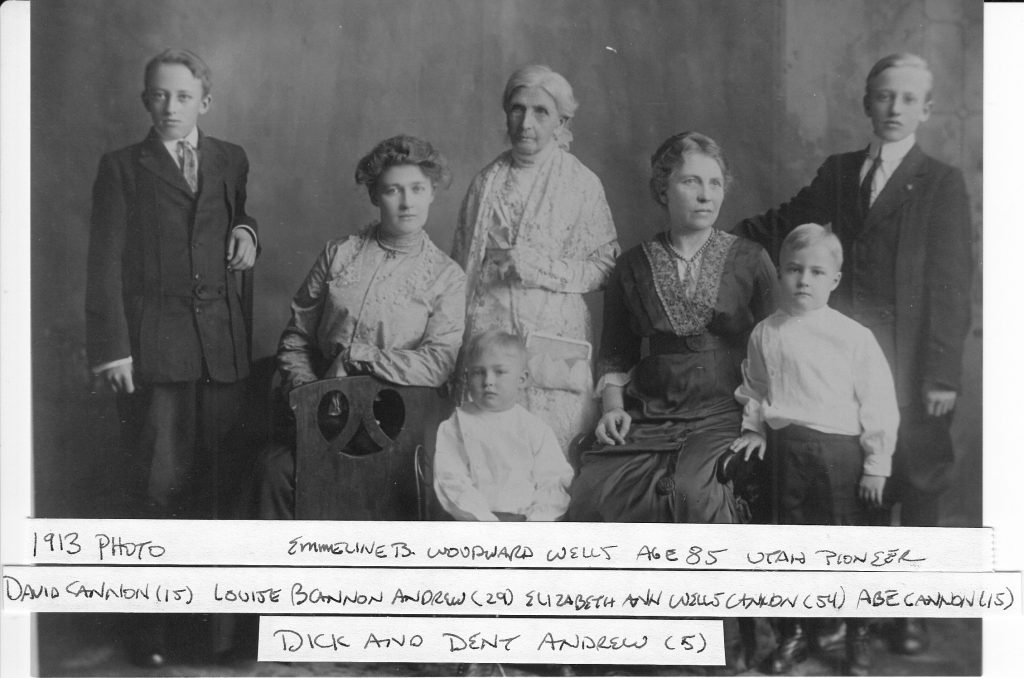
This is a link to a website to read Emmeline’s diaries: https://www.churchhistorianspress.org/emmeline-b-wells?lang=eng
Frederick Chadwick Andrew
The Andrew family converted to Mormonism in England. Andrew was a screwmaker by trade. His metalworking skills were in great demand on the journey over the plains and after their arrival in Salt Lake City. The Andrews sailed with a Mormon immigrant group to New Orleans and journeyed up the Mississippi to St. Louis and then on the Atchison, Kansas where the staging center of immigrant wagon trains had been established in 1854. It had been seven years since the first pioneers settled in the Salt Lake valley. in that time the church had improved their systems for moving new converts to their new home in the mountains.

The Andrews joined the Robert L. Campbell company and crossed the plains going from Atchinson to Kearney on the Platte River. There they joined the old Mormon trail for the rest of the journey.
Frederick Chadwick Andrew
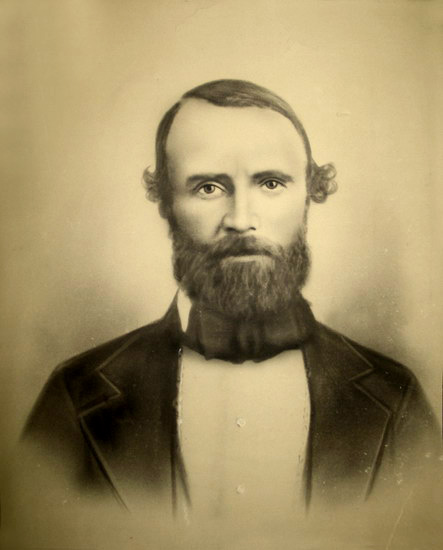
FREDERICK CHADWICK ANDREW Utah Pioneer of 1854
(Assembled by Clarence L. Gardiner – husband of Edna Jackson, who is a daughter of Esther Alice Andrew) May 30″‘, 1957}
To preserve to posterity an account of the life of FREDERICK CHADWICK ANDREW, the following incidents are herein recorded, including a brief account of his journey from Liverpool, England, to St. Louis, Missouri, and thence to his destination to Great Salt Lake City, Utah.
The only original material available for this record, is a diary written by him, recording his preparations for the long journey across and incidents transpiring on board the sailing vessel, until reaching St. Louis, where the narrative ended. Incidents in his life, subsequent to that time have been furnished by members of the family, together with some additional sources of information.
In the very infancy of the Church of Jesus Christ of Latter-day Saints, in November 1831, the Lord laid the burden upon the membership to “Send forth the Elders of My Church unto the nations that are afar off, unto the islands of the sea”, to proclaim the restoration of the Gospel and the setting up of the Kingdom of God. It was a vital and tremendous assignment, for at that time there could have been a very few available members holding the priesthood. However subsequent events proved the prophetic nature of the revelation, and today the thousands of members of the Church who have come from foreign lands attests the divine nature of the call of man to the ministry, and the magnitude of the missionary work
The labors of the twelve Apostles, sent to England in 1840, and which were centered more particularly in the central regions, from Liverpool, Preston, etc., on the west, across the island to the eastern shores, brought into the Church many thousands of sturdy, skilled artisans and yeomen, bringing with them into the Church their craftsmanship and skills, contributed greatly to the physical, material and spiritual building up of the cities, towns, and villages throughout the intermountain regions. Leaving their well ordered lives and surroundings in England, with amazing aptitude they became the builders in the pioneer community, utilizing their abilities in surmounting the obstacles confronting them in the new environment.
It was to this great middle-class of industrial workers in England that Frederick Chadwick Andrew belonged, and among which he contributed his skill. Life in England one hundred years ago, among the laboring classes was hard at best. The navies and merchant ships of Great Britain visited the ports and harbors of every land and clime, bringing the raw materials from distant lands, to be transformed into the finished products of her factories. Men were inured to long hours of toil and struggle against hardships anq, frequently, poverty, and while many of those coming into the Church were lacking in scholastic attainments, they had caught in their souls the vision of the future glory and grandeur of Zion and determined to bring to its progress and establishment the limit of their abilities. This conviction was strong in the character of Frederick Chadwick Andrew. He was a skilled worker in the iron foundry, his occupation and trade being that of a screw and bolt maker. This was a specialized vocation and required years of apprenticeship to qualify him to be proficient in the handling of molten metal, and of doing precision work in meeting accurate standards of perfection. With this technical training, we may be sure he would readily adapt his knowledge to a multitude of uses in his new home.
Arriving in the valley he commenced life by establishing a pioneer blacksmith shop, in which business enterprise he continued to the time of his death. By the forge and anvil he was busily occupied, shoeing horses and oxen, welding wagon tires and all the other activities of that vocation. He also used his talents in making many useful articles, among which was the earliest production of nails in Salt Lek City, the molding of flat-irons, etc.
The Andrew blacksmith shop stood on the north side of Fourth South, between Main and West Temple streets, and remained here during his lifetime and later, his son William, assumed the active management of it, so that it may well be said that the “village smithy” was an early landmark in Salt Lake City, and being in a favorable location, no doubt, did a thriving business. His home was located on the same block. He had three wives and quite a number of children, and his descendants now number several hundreds.
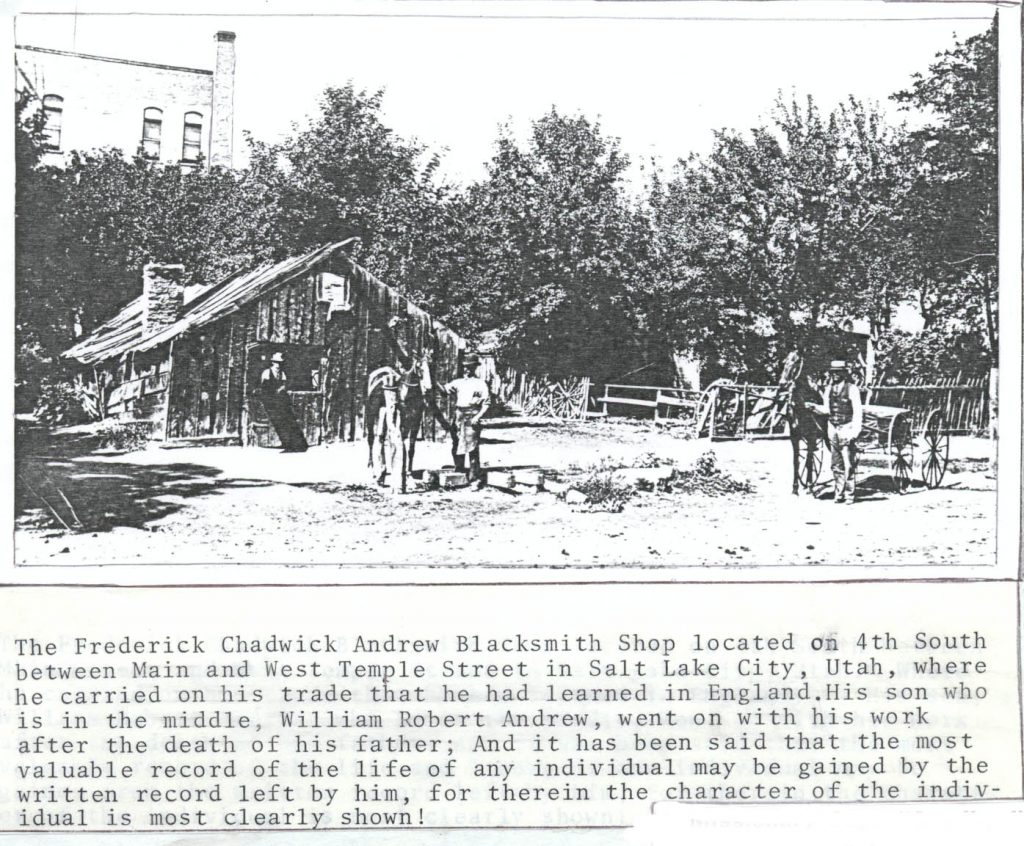
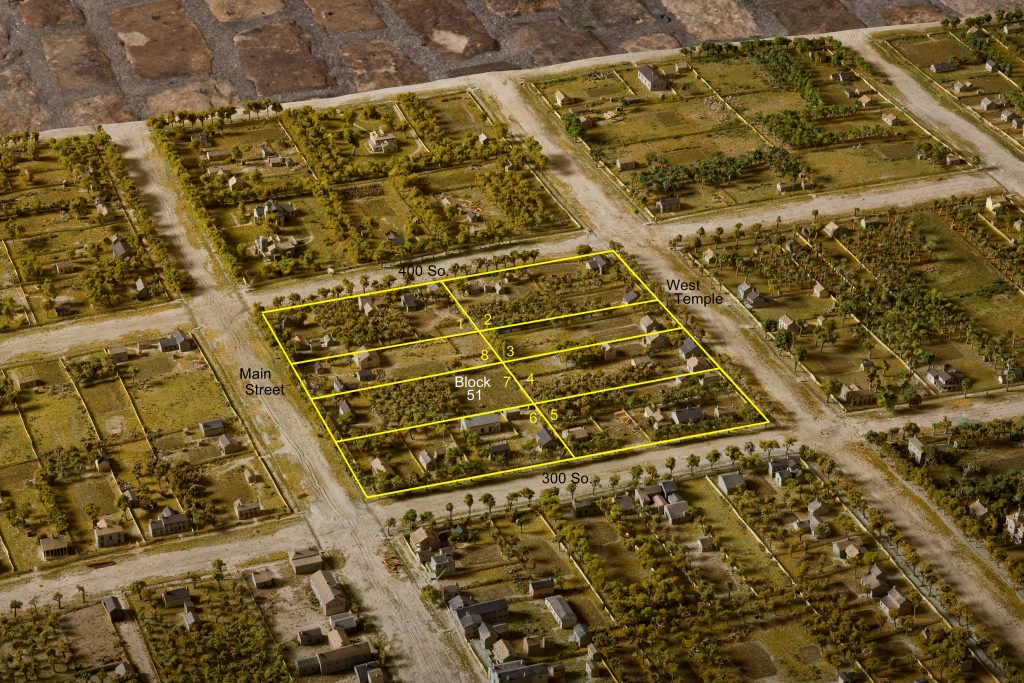
These early pioneers knew that the problem of life was not to make life easier, but to make men stronger, so that no problem should be beyond their solution. The Andrew name comes down to us through lineage untainted by luxury, uncoddled by charity, uncorroded by vice and uncrushed by oppression. From some research into the Parish records of England, it appears that the Andrew family, for many generations, resided near Stockport, Lancashire, in the vicinity of Manchester.
FREDERICK CHADWICK ANDREW was born 14th of June, 1820, in Heywood, Lancashire, England, the son of ROBERT ANDREW, who was born about 1796, and married ALICE CHADWICK, Robert’s father was RICHARD ANDREW, born about 1772, whose wife was MARY TAYLOR.
Frederick married Elizabeth Whitaker, July 17, 1842, in Middleton, England. She was born 3rd• of April 1822. Her father was JAMES WHITAKER, and her mother SARAH INGHAM living in Heywood Lane, Lancashire, England. From this union were born ten children, six of them in England, prior to coming to Utah, and four after their arrival.
Shortly after arriving in Salt Lake City, Frederick married in polygamy. MARY ANN FISHER, who came with his family from Stockport was his second wife, being married 19 November 1854 in Salt Lake City. Nine children were born into this family, whose names and dates of birth, etc. are recorded on the family group sheets in possession of the family. He was sealed to both wives in the Endowment House, 18 September 1857. Mary Ann died 3 February 1895.
Fredericks’s third wife’s name was SARAH ANN HUMPHREYS, daughter oflSAAC HUMPHREYS and SARAH GOODWIN and was born 5 December 1847. Two children are listed as members of this family. He was sealed to Sarah Ann 15 August 1863. She died 15 February 1889 in Sublett, Cassia Co. Idaho.
A personal diary written by himself, recording a few intimate incidents of his activity in the Church branch, and a rather detailed account of his preparation for, and journey across the ocean to New Orleans, and thence to St. Louis, where he was to commence the long journey to the valley. His account recites only the incidents prior to leaving St. Louis for the west. Many pioneers have recorded their journey across the plains, but few have left an account of the hazardous voyage by sailing vessel across the great deep, with its joys and sorrows; the high hopes of reaching their haven of safety, which were often turned to sorrow by the tragedy of a death among the company, and the sadness of lowering the body into a watery grave.
[Note: The Diary and Notes of Frederick Chadwick Andrew, taken from the Personal Diary written by Himself, can be found in: THE ANCESTORS AND DESCENDANTS OF FREDERICK CHADWICK ANDREW, Compiled 1979, Pages 44 to 58.]
Rather abruptly, the diary of Frederick Chadwick Andrew terminated. The long and arduous journey from St. Louis to the Valley was still ahead. It would be interesting to his descendants to have his story, giving the details of his daily experiences and how he met the problems confronting him, and his great contribution to the welfare of the company. His training had eminently qualified him for the vicissitudes he would meet in traversing the vast stretches of the western plains and mountains. As a skilled mechanic, his services may have been so much in demand in keeping the outfit in repair that he had no time to keep a record of his activities, and it would seem that his identity was almost lost in the mass of humanity crossing the plains, but we can be assured that he did not forget to give thanks to that God, to whom he so often expressed gratitude for His protecting care while crossing the ocean.
The long journey was at last ended, without any loss of members of his family, and life was to begin anew for them in their new home. Again referring to the record we learn: “Saturday, October 28th 1854: Robert L. Campbell’s company oflmmigrants, the last of the season, arrived in Great Salt Lake City”
The year 1854 records some interesting events in Church history relating to conditions in Salt Lake City, and the Church abroad.
Kansas City, Mo. Was selected as the outfitting place for the Saints crossing the plains. Dr. Willard Richards, counselor to Brigham Young, died. Sugar House Ward was organized. Workmen began at the southeast corner to lay the foundation of the Temple. Grasshoppers did much damage to crops. President Young advised the presidency of the British Mission to ship the emigrants from Europe to a more northern port than New Orleans, as the latter place was very unhealthful. The wall around the Temple block was completed. The British Mission recorded a Church membership in Europe of 32,627. Of these 29,441 were in Great Britain.
The domestic life of the Andrew family was most congenial. Separate apartments in the commodious home were provided for each wife and their children, each assuming the duties of the household to which they were best adapted, such as sewing mending, laundry, etc. The grandchildren
who occasionally visited in the home all testify of the harmony and happiness that existed between the families; and this spirit characterizes their descendants who now associate together in their annual gatherings of the organization known as the DESCENDANTS OF FREDERICK CHADWICK ANDREW. The blacksmith shop proved a successful venture and provided, during the years, an income sufficient to provide all the ordinary requirements of the families, and some of the luxuries. For twenty-four years, from 1854, to the time of his death 2nd• of March 1878, Frederick Andrew carried on his vocation, and the sentiment expressed in Longfellow’s poem., “The Village Blacksmith” might well apply to him.
“Toiling, rejoicing, sorrowing, Onward through life he goes;
Each morning sees some task begun, Each evening sees its close.
Something attempted, something done, Has earned a night’s repose.”
After the death of Frederick Chadwick Andrew in Salt Lake City, William Robert, the eldest son of Mary Ann Fisher Andrew, operated the blacksmith shop for many years.
The most valuable appraisal of the life and labors of any individual may be gained from the written record left by him, for therein the character of the individual is most clearly shown. Only one other item of record, written by him, attempting to give expression to the deep emotions of his soul, is at present available. This is an original poem, in his handwriting, written on the fly-leaf of an early volume of the Millennial Star, signed by him, and dated December 28th • 1852, while still in England. We insert it in this record as a valuable contribution to this brief biography.
Oh! How glorious will be the morning When Christ shall come on earth again: The Saints of God for him are waiting,
A thousand years with him to reign.
CHORUS
Repent and be wash’d clean from sin And then a crown oflife you’ll win’ For the day we seek is nigh,
Is nigh at hand.
Let us trim our lamps and keep them burning And be ready when He says “Well done”, Lest we should die when we behold Him, For His glory’s brighter than the sun.
The lamb and lion shall dwell together,
When the righteous reign it doth commence, Then the second death shall have no power
For pain and death shall be banished hence.
Oh! We are the Bride adorning And preparing for the Great I Am, Then we shall all receive a blessing
At the marriage supper of the Lamb.
The numerous and every increasing descendants of FREDERICK CHADWICK ANDREW may take just pride in the life and achievements of so illustrious an ancestor and the heritage he has left to them. Dr. Beecher says: “The memory of our fathers, should be the watchword of liberty throughout the land, for, imperfect as they were, the world before had not seen their like, nor will it soon, we fear, behold their like again. Such models of moral excellence, such apostles of civil and religious liberty, such shades of the illustrious dead looking down upon their descendants with approbation of reproof, according as they follow or depart from the good way, constitute a censorship inferior only to the eye of God, and to forget or ridicule them is national suicide”
Another author has said: “It needs no elaborate argument to show the propriety of a clear and accurate record of one’s ancestors. A few persons may make the pretentious claim that all importance centers in themselves, and that all that came before is naught!” To which we answer in the words of Daniel Webster: “The man who feels no sentiment of veneration for the memory of his forefathers, who has no natural regard for his ancestors or his kindred, is himself unworthy of kindred regard or remembrance”.
The foregoing material, admittedly so incomplete, is submitted to the ORGANIZATION OF THE DESCENDANTS OF FREDERICK CHADWICK ANDREW, in the hope that future research may bring to light additional vital facts relating to the life and ancestry of the subject of this sketch.
NOTE; Copied from the original, with a few minor changes in format, by Esther J. Wallace (August, 1997)
I am including these additional pages as a historical summary of life at sea in the 1840’s – the dependence upon the weather for movement, etc. – also, of interest, is the dividing of the converts sailing to America into units with stewards appointed over them. Thus we see “order” in the mass movement of religious immigrants and we are reminded of the statement “My house, is a house of order”. I give full credit for this work to Clarence Gardiner. I have made very few changes in spelling or writing. I have, however, taken the liberty to delete passages and notations without so noting. This year (1998) marks the final year for an annual reunion of the descendants of Frederick Chadwick Andrew. Hopefully, younger generations will carry the torch of “keeping in touch.” (Esther J .Wallace)
FREDERICK CHADWICK ANDREW PREPARATION FOR, AND SAILING — ENGLAND TO AMERICA
It appears from a letter sent to Samuel Richards, the then president of the European Mission, that Frederick had intended to emigrate early in 1853, but circumstances prevented it. The latter part of 1853 however, found him making active preparations, and on January 10, 1854, he advised President Richards that he was enabled to leave at an early date and posted with the emigration authorities, forty pounds as part pay for their emigration to the Great Salt Lake Valley. He had received from some of his relatives and neighbors, who had preceded him to America, letters describing the length and hazards of the long journey, and giving him valuable information as to what supplies, tools, etc. would be of the most value in making the trip – including also what supplies and materials were in short supply in the valley. This information, no doubt, was of inestimable
value in determining the kind and value of supplies assembled before proceeding, and of eliminating many needless items. He was instructed to bring “twelve yards of fine linen, one yard of green Persia silk and one yard Buckmuslin, each for Temple robes. One parasol each, one white veil and one black veil each. Plenty of remnants of prints of small patterns for sun bonnets, sacks and aprons.” He was also advised to bring a good tin cup, a deep plate, a tin dish, a small washbowl, a small iron pan and a gallon water can – and these should be made in Stockport.
From Salt Lake, came the request for a spade, a shovel, a potato fork, and a couple of hoes with steels, jointing planes, augers to fit a 2 inch bore, an oil stone, cold chisel, etc. – tools of the trade that would be useful, and not in supply in the valley.
December 1853
According to the spirrit of the times we feel desireous to gather with the Saints of God. 1 think I shall be able to raise 10 pounds a head (along with Sister Fisher) towards our emigration as is spoken of in the Star and I hereby send eight pound per head as deposit according to request for the following five persons 40 pounds.
- Frederick Andrew aged 33 years Screw Bolt and Nail maker
- Elizabeth Andrew aged 31 years House Keeper
- John Andrew aged 8 years
- Samuel Andrew aged 19 months
- Mary Ann Fisher aged 26 years Silk Weaver
P.S. 1 should like to sail in the vessel nearest the 20th of February 1854.
January 21, 1854 we find him busily engaged in preparation for the long journey.
Friday, Feb. 241 1854: I left Stockport on the half past ten o’clock train for Heywood. I arrived
safe, and visited the ship that I had to sail in, “John M Wood”, and I found it one of the finest vessels that we had seen. It is about 60 yards long and about 45 feet broad and 7 feet 8 inches between decks in the steerage.
Monday, Feb. 27h: I went and got my ticket of my luggage and then went and met my wife and children at the railway station.
Wednesday, March 1′1: Today we went down to the ship and took our luggage on board and slept in the ship and received our week’s allowance of provisions.
March 3rd: Still very fine weather and the ship is still in the dock, not having her cargo yet. Men are working night and day, loading her with railway slips and other things.
March 4th: Still in dock boxing in and preparing for our journey. This day I am appointed to watch a part of the ship from 12 o’clock to 4 o’clock Sunday morning.
March 5th, Sunday: weather very fine but rather cold. This day the Saints are divided into 8 wards and districts and 8 presidents are appointed over them to see that order and cleanliness are observed and that the Saints meet together for prayer night and morning. Also Brother Campbell is appointed president over the whole company and Brother Woodward and McDonnell, his councellors.
Tuesday 7th: Fine weather and the wind fair, but the vessel cannot go out of dock on account of low water.
Wednesday 8th: Ship removed yesterday but not out of dock and now waiting for high tide for her to go out in the river.
Thursday 9th: weather very fine and favorable but we are still in the dock. This day they have made up the hatch-ways and cleaned down the decks ready to take off
10th and 1Jlh: We are still in the dock stowing in our cargo and all is well.
(Sunday, March 12, 1854, the ship John M. Wood sailed from Liverpool with 393 saints, including 58 from Switzerland and Italy, under the direction of Robert L. Campbell. It arrived in New Orleans May 2nd.)
12th, Sunday: This morning the tide is pretty high and we are preparing for leaving the dock 18 minutes past 10 o’clock. The tide is up and the Steamer is come to tug us out. We go with a good breath until the steamer has left us and about 4 o’clock the sun is very powerful and not a breath of wind to be felt. Scarsely it appears as if we had got into another climate until towards night the wind began to rise and about 12 o’clock it began to blow very fresh, so that they had to reef the sail and tack about.
The notations of the 13th through the 2l51 tell of hopes of favorable winds and clear skies being of short duration. Shortly after leaving port, while proceeding through the Irish Sea, on Monday March 131 they encountered heavy head-winds which continued to blow very hard against them, so that it tossed the tins and boxes about, causing nearly all on board to become sea-sick, and the wind attained such velocity that it was necessary to take a pilot on board and tack about and go back again all night. The next day they were still being blown back towards Liverpool, and very near to the shores of Wales. However, later in the day the winds abated and the sea became calmer. On the morning of the 15th, following two days the wind again beam very strong against them so that they had to tack about many times in order to make a little progress. They passed close to Waterford in Ireland, and were about to leave the shores and proceed into the broad Atlantic. The pilot that had guided then through the rough weather of the Irish Sea left them.
As the weather appeared to be fine, though quite squally, they hoisted the stan sails, but the winds broke one of them. The same accident occurred the following day. The weather was extremely cold on Sunday however Monday and Tuesday they were well away from the Irish channel and were going on at a pretty good rate from 8 to 10 knots per hour.
Wednesday 22nd: This is a beautiful morning. The wind is fair and the sun shines bright and it is a great deal warmer than it has been. They have hoisted out their stan sails and we are going at a good rate. Most of the passengers are on deck and we have singing and music playing of various description, so that all seem to be very much alive.
The weather continued beautiful. His family were all well. Frederick took his tum to look after the cooking for his Branch. He reported that the cooking galley was very warm. The death of a 12 month old child, ill before coming aboard, is recorded.
Friday, March 24th this morning is a thick dull heavy morning and colder than it has been this last day or two. Afternoon it is raining. The wind is rather brisk but it is above the beam yet. We are going at a nice speed and steady.
Saturday 25th: This morning is calm and the water is smooth and we are making very little progress yet the vessel rocks much. Afternoon, the wind rose a little towards 12 o’clock and we went very well after.
Sunday 26th: This morning we have a good wind and the ship goes very steady and at a good rate. We have had a meeting today commencing at 11 o’clock when Brother McDonnald preached.
The next day a calm sea with a little rain, followed by sunshine, making it very pleasant on deck. The previous day another child died of “inflamation of the chest”. It was well a week ago. Head winds continuing for the next few days caused the vessel to rock badly, which caused many to be sick. And thus ended the month of March.
Saturday, April J81: Last Monday morning my feet slipped from under me and I lit against some pig iron that was lying on the deck and bruised my foot a little, before and below my ancle but today it is much better. I have put an oat-meal poultice on it three times with a little oil. I have a poultice on it right now. Last night I took some cayenne and got a sweat nearly all night which I believe has done it much good.
Sunday, April 2nd: We have had another death of a child. It is awfully grand tonight to watch the sun go down in the west and cast its golden rays between the clouds and to see the mighty waters all in motion, and of rain. Also the clouds hang in the air with various shades, and the moon about 2 or 3 days old, above our heads shines bright and the stars all around us glitter like silvery dots in the firmament, so that the scenery altogether is beautiful.
Monday, April 3rd Sister Day died She had been ill a long time. She was let down into the water.
Wednesday, 5th: This day we are rather becalmed and we have gone very little.
Thursday 6th,- This morning we was at a stand not a breath to move the water and it was as smooth as glass. We have gone very little today if any. This day is the anniversary of our church and they have appointed a general fast day to be made of it and to be observed as Sunday any other way. But
the people was not very united about it. We had a very good meeting and we was addressed by nearly all the presidents.
Thursday 13’h: The calm continues and the sun is very powerful which makes it very warm but we had had some nice showers every day this week which is very refreshing. We had a little bustle about half past twelve today. The awful cry of fire saluted our ears and soon after buckets of water was tumbled upon the cooking gally and the pump was soon in motion so that it was soon extinguished. It was the top of the cooking house that took fire with the stove pipe being so hot and the timber so dry. We was just having our dinner upon deck at the time. Afternoon the wind came up and we went along very nicely.
Friday 2J81 Early this morning we passed the Bahaman Islands on our left and entered the Florida
Gulf and stream. The route being strange to the Captain and mates. I understand we was near running ashore. They dryed the depth of the water and found we had only 8 l/2 yards deep. This is another beautiful morning and we are going first rate down the Gulf. Yesterday we saw 2 or 3 dolphins swimming by the side of the vessel. They are beautiful fish. They appeared to be of a green and blue color and about 2 feet long. This morning our John wanted the bucket to wash his feet and legs. I let him have it but he was not long before he came crying. The third mate had broke the bucket and kicking it up and down the deck. I went and had a few angry words with him but of no good. It only made me more uneasy for they will not hearken to anything you have got to say so the best way is to keep out of their way as much as possible, and have nothing to say or do with them. Yesterday the same man threw a night tin over board because it was lying on the deck.
Saturday, April 22nd We are now sailing up the Gulf of Mexico and we are goingfirst rate. It is p beautiful morning. The vessel sails as steady as if we was standing still and has done a day or two., Yesterday our Samuel began to walk himself for the first time on the vessel. He has always been afraid on account of the vessel rocking. Evening -1 was misinformed. This morning we were not in the Gulf. We was in the streams of Florida.
Expectations of soon landing were high and many took the occasion for writing letters to their families and friends in England. Entering the Mississippi River was a very hazardous undertaking because of the great sand bars that formed in the delta of the river. Ships, particularly those sailing in the dark, were in danger of being wrecked or stranded on these banks. So the captain came on deck and ordered the sails drawn up immediately, slackening the speed of their vessel.
Thursday, the 21h: The waters were quite calm and the sea-weary passengers were cheered by the pleasing sight of fresh water coming down the Mississippi. About 10 o’clock there came a steamboat for the purpose of piloting them up the river, but for some reason the arrangements were not completed, and it left. After the steamer left, the captain hoisted a color up on the mast top and it was not long before they had a pilot boat along side and the Captain engaged the pilot boat. They soon came to the bar in the river. Many signs of their near approach to land were seen.
Friday, 2Sh: I rose this morning about 5 o’clock and went on deck and found we was anchored along side of the bank of the river waiting for a steamer to come and tug us up. We was surrounded this morning with 14 or 15 vessels all seemed to be at anchor besides 4 or 5 steamers plying about. · About 10 o’clock there came two steam boats and tugged us up across the bar up to the belize and there we anchored. The belize is like a small village by the side of the river where the pilots live that tugs the vessels over the bar and up the river. The bar is where the Mississippi River empties itself into the sea or gulf. The river spreads out wide and loses its force and lodges a great deal of mud and dirt there and forms a bar so that the vessels cannot go over without steamers to drag them through. The weather has been very cold since we came here so that the passengers has had to put more clothes on.
The next day the sailors were very busy hauling down the sails and preparing for the trip up the river. April ended with the ship still anchored at the Belize. May 1st dawned clear and beautiful. The sailors were busy cleaning and painting the ship both on deck and outside. About eight in the morning two steamers came along side, one on either side of the ship, and drew them up the river. The beautiful scenery along the river banks presented itself to their view, plantations of sugar cane, orange trees, and other kinds of great variety. Little Samuel seemed to enjoy the sight very much, shouting and clapping his hands and pointing his finger to show them that he was enjoying it very much. They also passed two forts, which were built to prevent any enemy from going up the river. Passing up the river through this lovely scenery, they arrived at New Orleans about 2 o’clock on Tuesday, May 2nd. Thus ended the long ocean voyage of 51 days from Liverpool.
May 3rd was a busy time for the Saints. All was hurry and bustle, with the passengers hauling out their boxes and getting them ready for the customs inspection. They were busy all day opening their luggage for inspection and then getting them into the steamer that was to convey them up the river to St. Louis. About 5 o’clock in the evening they started.
Thursday, May 411 We are still persuing our journey up the Mississippi River and on each side it is beautifully decorated with green trees, plantations, etc. It is delightful to behold. It is worth all the journey to see the sight. The steamer stops about 3 or 4 times a day at various stations all up the river,for to take in wood for to burn. They burn about 40 cord a day. That is about 40 tons.
The joy awakened by the grandeur of the scenery and the hopes of reaching the end of their journey on the water, was soon turned to sorrow and consternation by the invasion of the dread cholera in their midst. Progress was slow as the mists were so heavy they could not discern the proper channel to steer into. Nearing Memphis, they intended to stop there a short time, however the steamer ran into shallow water and stuck fast in the sand soon after midnight. The following day they were still fast on the sand and the men were working to get it off by winding the forepart of the boat up and shoving it back in deeper water. About 11 o’clock in the forenoon they succeeded in getting loose and proceeded to Memphis.
Proceeding to Cairo they were called upon to pass through the quarantine, opening all their luggage again and being ordered by the Doctor to place all of it in an old building that was there for the purpose of lodging foreigners, and to take in all the sick. This place was on a small island in the middle of the river and the company had to sleep in an old boat that was there for the purpose of having the emigrants wash and clean their clothes and air them. They cooked on the shore upon an old stove and with fire kindled upon the ground with wood. The ravages of the cholera continued with several more deaths.
Thursday, May 18th There is a great change in the weather since yesterday. It is very hot today and we are preparing to leave the quarantine. Between 4 and 5 o’clock the tug came for us so we got all our luggage upon it and then we sailed up to St. Louis and went on board the steam boat Samcloon the same night. It was only the emigration fund passengers that came up tonight. The ordinary passengers will come up by themselves in another boat.
Thus, abruptly, the diary of Frederick Chadwick Andrew terminated.
Elizabeth Whitaker
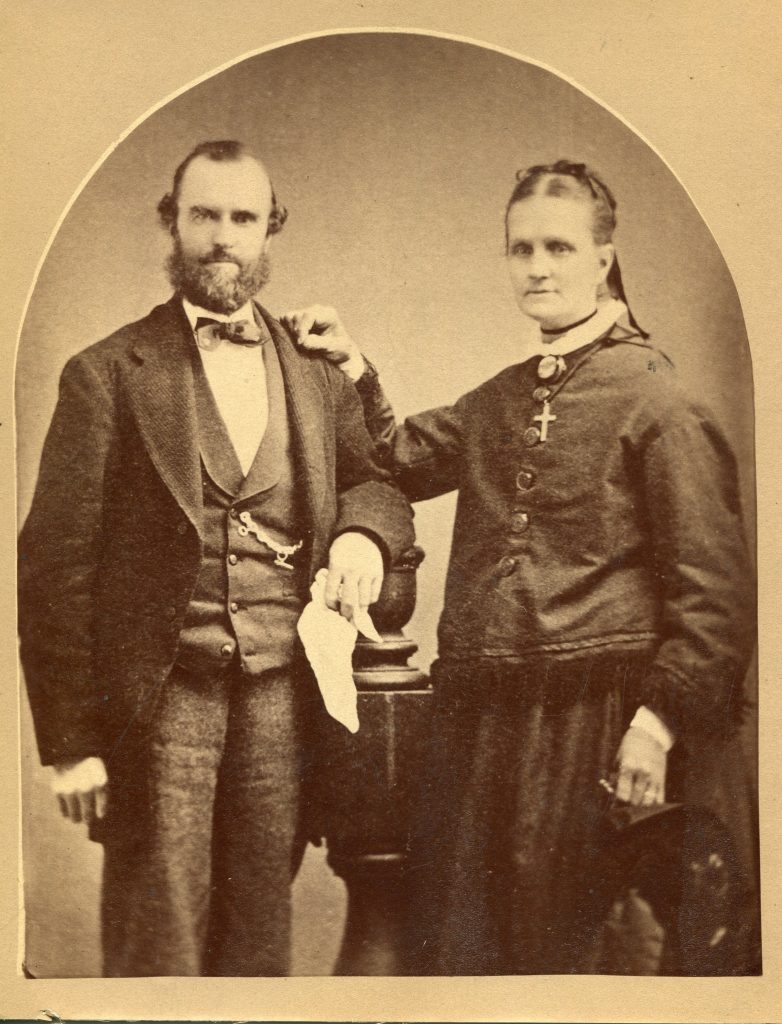
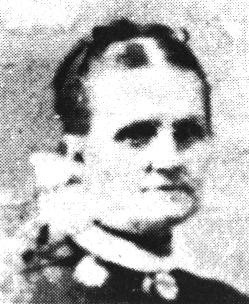

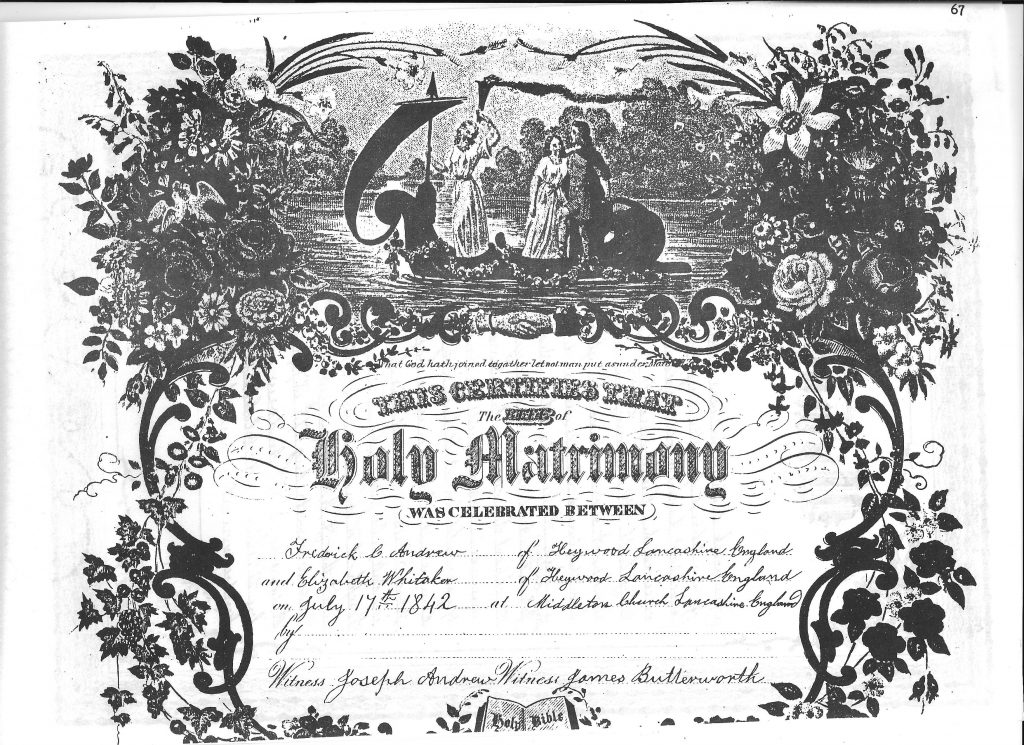
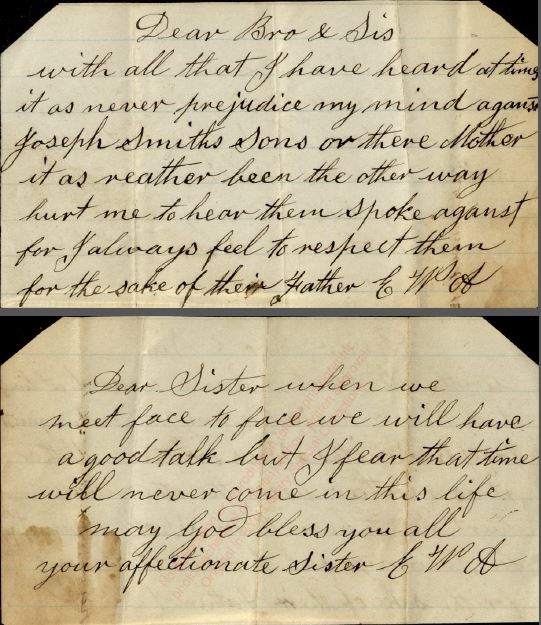
“Elizabeth Whittaker was born 3 April 1822, the second child of James Whittaker and Sarah Ingham, at Heywood Lane End in Heywood, Lancashire, England. She was christened in the Parish Church 5 May 1822.
Her father was a weaver by trade and of English descent. By a previous marriage to Mary Taylor on 24 November 1795, seven children were born. Mary Taylor died 22 May 1816.
Elizabeth learned the trade as tailoress, possibly while living in Heywood. She married Fredrick Chadwick Andrew, the son of Robert Andrew and Alice Chadwick, 17 July 1842 in the Parish Church of Middleton, Lancashire, England, which was approximately three miles south of Heywood.
Their first child, James W. Andrew, was born 31 May 1843 in Heywood Lane, Heywood, Lancashire, England, and died 2 Jan. 1845. John W. Andrew was born 27 August 1845 in Heywood, Lancashire, England. Fredrick W. Andrew was born 13 April 1848 in Heywood, Lancashire, England, but died 12 November 1848.
It is assumed that at this time they had heard the gospel of Jesus Christ of Latter-day Saints and moved to Heaton Norris, a suburb of Stockport, Lancashire, England. From her notes we find Elizabeth was baptized 12 July 1849 in Stockport, Lancashire, England by Elder John Wood, to the Church of Jesus Christ of Latter-day Saints. Her husband, Fredrick Chadwick Andrew, was baptized later in December 1850 by Elder James Shelmerdine in Stockport, Lancashire, England.
Another son, Robert W. Andrew was born 21 April 1850 and died 16 August 1851 in Stockport
Twins, a boy and a girl, were born to them 18 May 1852. The girl was named Alice Whittaker Andrew and died 11 August 1852 and was buried in Stockport, Lancashire, England. The boy was named Samuel Whittaker Andrew.
The cause of the death of their children is not known at this time. After long months of planning and saving for the journey to America, we can imagine their anxiety and sadness in the death of their children and their longing to be delivered from “Gentile bondage, and to emigrate to Zion to join the Saints of God,” as Fredrick Chadwick Andrew writes in his diary. At last their prayers were answered.
On Sunday, 12 March 1854, the tug boat pulled them out to sea to begin their voyage. The family consisted of Fredrick, his wife, Elizabeth, their sons, John and Samuel, and Mary Ann Fisher, who assisted Elizabeth with the children (as is mentioned in the diary).
They sailed on the ship John M. Wood. The family stood the trip well except for severe sea sickness, etc. Fredrick noted in his diary, “Many deaths much sickness and bowel trouble at sea.”
Nothing was mentioned of Elizabeth’s activity on the ship but, assuming with her motherly love, she gave her services wherever they were needed. Fredrick mentioned making a big plum pudding for “Sister Andrew’s birthday.” He mentioned that Samuel learned to walk on board ship and his wife was very sick with bowel trouble, just before they landed in New Orleans.
The journey was no doubt hard for all, old and young. Some dearly beloved ones had finished their earthly journey before they reached land and were wrapped in sheets, tied to a board and lowered into the ocean. Those who remained, comforted the sorrowing ones, their heartaches and anguish. They had left all precious possessions behind and brought only necessities. Nevertheless, each day they were filled with contentment that they were in the Lord’s work and were helping to fulfill his prophecies. They longed for the freedom in their new surroundings in Zion.
Landing in New Orleans in May, they traveled up the Mississippi River for 16 days, enjoying the sights of plantations, lush vegetation, and the wonders of a new land. As Elizabeth’s husband stated, “It is worth all the journey to see this sight.” After spending three days checking through the quarantine station, they continued on to St. Louis, arriving on May 18, 1854, where they began their westward journey across the plains for five long hot months. No doubt struggle and privation followed them, but loyalty and devotion to the Church never failed.
Upon arriving in Salt Lake City, Utah, Elizabeth consented to entering into plural marriage. On the 19 November 1854, Fredrick married Mary Ann Fisher. Elizabeth welcomed her and they were congenial one to another. It is said that Elizabeth did most of the sewing while Mary Ann did the cooking.
Their home was built on Fourth South between Main Street and West Temple Street, with separate apartments for each wife. Fredrick’s blacksmith shop was also built on this lot, where he shod horses and made screws and square nails for use in the many implements and buildings necessary in a new community. On 18 September 1857 Fredrick, Elizabeth, and Mary Ann entered the Endowment House where he was sealed to each wife for time and eternity.
Elizabeth brought ten children into the world although she raised but four sons to manhood. Perhaps Elizabeth, like many pioneers, has passed on with little known of her many kind acts to her family and friends. One of her daughters-in-law, who knew her well used to tell her children how “Grandma Elizabeth gathered raspberry leaves and herbs of different kinds and washed and dried them to store for winter medicine.
She also helped her husband set and bandage broken bones. She often went out as a midwife when called to deliver babies. She made a very good glue from hoofs of cattle, some of which was used on a piece of furniture now owned by her grandson, Richard Andrew, which he prizes. She also made pretty hats from rabbit skins. She was one who did much writing, recording work done in the Salt Lake and Logan Temples. She is remembered as being rather short and slender and medium complexion.
Families who in their histories have stories of personal contact with the early leaders of the Church, cherish them. She no doubt was personally acquainted with President Brigham Young, Wilford Woodruff, and others, having lived most of her life among the leaders of the Church.
Her husband, Fredrick, died 2 March 1878 at the age of 58 in Salt Lake City, Utah. She spent her later life with her son, John, in Salt Lake City, Utah and her son, Samuel, of Springville, Utah, where she died at the age of 72, on 21 February 1894. She was buried by the side of her husband in the Salt Lake City Cemetery, Salt Lake City, Utah.
As we read the above facts about her, we realize the marvelous story that lies behind this sketch. What inspiration her descendants should have in reading about her, and the life she lived. Not a single word of her told or retold experience of her testimony of the gospel had been recorded by her or her descendants. For the most part they had paid little attention to her in their busy days.They know little more about her now than is written here.
When a long life righteously lived ends, there is sorrow and loneliness among those affected, but it is not a bitter experience. She experienced much sorrow and questioning inherent in the deaths of her many children. As with Elizabeth, death takes a person with recollection of childhood, with knowledge of unrecorded dates and places pertinent to family genealogy and testimony of the gospel, and it is realized too late what great wealth has been lost. Younger generations are often in awe at grandmother’s courage, faith and ambition to combat the hardships she encountered.
Though it is realized that this history is necessarily incomplete, may it be recorded so that more may be known of our noble ancestor and true pioneer, Elizabeth Whittaker Andrew.”
Compiled by Esther E. Andrew and Adelphia A. Triptow
Elizabeth died 21 February, 1894 and Sarah a year later on 15 August, 1895. The sisters never saw each other after arriving in this new land and although they had their differences, their love remained constant. In one of the notes [undate] penned to Sarah, Elizabeth said, “Dear Sister when we meet face to face we will have a good talk but I fear that time will never come in this life. May God bless you all.”
Your affectionate Sister, E. W. A. [Elizabeth Whitaker Andrew].
Charles and Anne Stanger Hogg
The Hoggs and Stangers were also English converts who sailed with a Mormon charters ship from Liverpool to Philadelphia in 1855. They then travelled by train to Pittsburgh and wo steamboats. First to St. Louis and then on to Atchison, Kansas. They stayed at a campground called ” Mormon Grove” just east of Aitchison and helped put in crop for those who would follow. Companies were formed to cross the plains. The Hogg and Stanger families were part of the Richard Ballantyne company from 2 July to 22 September 1855.

Charles Hogg and Ann Stanger
Charles Hogg, son of Thomas Hogg and Ellen Rowland was born on 18 Sep 1831 in Deighton, Yorkshire, England. He died on 09 Oct 1901 in West Weber, Weber, Utah. He married Ann Stanger, daughter of James Stanger and Isabella Thompson on 26 Jun 1852 in Faceby, Yorkshire, England.
1.6 Ann Stanger, daughter of James Stanger and Isabella Thompson was born on 04 Apr 1828 in Faceby, Yorkshire, England. She died on 31 Oct 1899 in West Weber, Weber, Utah.


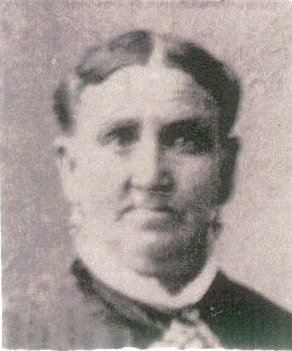
The Stanger and Hogg families were converted to Mormonism in their home town of Faceby England. This is the story of the Mormons in Faceby:
“Faceby in 1852: first encounter with Mormon missionaries:
It seems that the Stanger and Etherington families first met a Mormon missionary in 1852. George Stanger’s family remembered the missionary as a young man called Elder William Burton. Perhaps he was travelling between the church’s branches in Leeds and County Durham and found himself in the neighbourhood. He was able to find somewhere to hold a meeting – perhaps a Temperance Hall or Nonconformist chapel. One of the Stanger family went to the meeting and was so impressed by what he heard that before long, more missionaries were visiting the Stanger’s home in Faceby. The family and their neighbours became convinced of the truth of the new teachings and soon the visiting elders were baptising new members, probably in Faceby beck.
1852 was to bring further changes to the Stanger’s and Etherington’s lives. The Etherington’s daughter Elizabeth was married in London to a coachman named John Pugh, but their young son George died in Faceby at the age of twelve. John Stanger married and began farming at Landmoth near Leake, and Ann Stanger married Charles Hogg on 26th June.”
Charles Hogg
Charles Hogg’s account of his life is of great interest. It suggests a man capable of extremely hard work, but of perhaps narrow views. He mentions his father-in-law only once and his brothers-in-law not at all; possibly he was writing for his family by his second wife.
Hogg was the son of a stock dealer in Deighton near Northallerton, and was one of ten children. He was broken to his father’s business at the age of five or six, and hired out to a farmer to drive a team of horses when he was seven. He then worked in the brick yards for three summers, and “without much chance to go to school I did learn to read and write a little, and studied arithmetic a little.”
He then “hired out to a farmer named Thomas Webster when eleven years of age for one year. My wages being two pounds ten shillings or twelve dollars and fifty cents for the year.” He spent three years and six months with Webster, and then worked as a farm hand until he was 19 years old. For the last five years of his life in England he worked as a drainer. “I had to assist father’s family (as wages were very low) to get the necessities of life”.
Hogg records becoming “a little acquainted with the Gospel of Christ as revealed to Joseph Smith” in 1852 and the account of Ann Stanger Hogg’s life written by her descendants records that this introduction to the Mormon faith happened “soon after their marriage” in meetings with Mormon missionaries from Salt Lake City, many of them held in her father’s house. The account of Elizabeth Etherington in “Pioneer Women of Faith and Fortitude” (biographical sketches of early Mormon women, supplied by their descendants) states that she and her husband heard the message of the restored gospel from a missionary in 1851 and were converted; this date may not be correct, as John Etherington was still a church warden in 1852. However, it does suggest that Hogg was joining an existing group in Faceby and that missionaries were already becoming regular visitors there.
Charles Hogg was baptised into the church on 29 May 1853 by Moses Clough (or Cluff) and “bore my testimony in a public meeting four weeks after, held in the house of James Stanger.” Moses Clough was a young man of twenty four, fresh from Utah, and must have been an inspiration to the young people of Faceby.
1853: the Faceby Branch is established:
The Faceby Mormons were becoming increasingly committed to their new faith. They were undeterred by the announcement in 1852 of the revelation instituting polygamy. The announcement of this practice led to derision in the press and amongst the public. One Elder, speaking at the Newcastle conference in May 1853, commented that “in some places there has been some who have questioned the motives of those men, and have in consequence had peculiar feelings towards them.”
In July 1853 Thomas Stanger, still unconverted, married Jane Wilson, a dressmaker, in the parish church. She and her brothers Thomas and William seem to have returned to their mother’s village at some time after the 1851 Census; their father’s family was from Bilsdale and is thought to be connected to that of the late prime minister, Harold Wilson. Thomas Wilson was to become a Mormon and emigrate with the others in 1855; William may have become a member at the same time, but he remained behind.
In Leeds, Ann Etherington married a labourer, Thomas Heslop, and they came home to the farm in Faceby for the birth of their son John in June (an IGI entry records his birth in “Fecely”, which must be a misreading for Faceby). They too were caught up in the growing excitement.
In September, Ann Stanger Hogg was baptised a Mormon and Charles Hogg was ordained a Priest by Elder Thomas Squires. Charles was now able to take charge of the meetings in the absence of Elder Clough. Now the intensity of the new religious experience was growing and missionary work occupied more and more of their time. By December 1853 they had formally established a Branch of the Mormon Church in Faceby with 16 members, and they sent a representative to the quarterly Newcastle Conference.
Charles Hogg remembered that, “It took all our spare means we could get to buy tracts, and feed, and clothe the traveling elders, of which many came amongst us. The few saints of Faceby Branch did manfully; assisting in those temporal affairs for so small a branch, and members so young in the Church. I continued to instruct the saints and travel around in the surrounding country whenever we had time, holding meetings, bearing our testimony whenever we had a chance”.
Unfortunately we have no record of the reaction of their neighbours and the local clergy; Mr Barlow of Hutton Rudby must have been particularly affected.
In April 1854, Charles Hogg was ordained an Elder and called on to act as President of the Faceby Branch. Now he had the task of planning and presiding over meetings and assigning responsibilities to members. He took his new position seriously, “Here let me say I did to the best of my ability to warn the inhabitants of that part of the country to receive the eternal truths of Jehovah, that have been revealed through the Prophet Joseph Smith.”
In July 1854, when Elder James Macgregor represented the Branch at the Newcastle conference, it had 15 members and two baptisms had been performed.
Possibly the numbers in the Branch varied with the arrival and departure of visiting elders, but they may have been affected by the departure of James Stanger senior and his wife Isabella. In the early summer of 1854 their son John’s wife had died at Landmoth, leaving a two year old girl and a baby of three months, and at some point they left Faceby for Landmoth, presumably to help John with the children.
The Branch was still gaining converts – Thomas and Jane Stanger’s daughter was baptised in the parish church in June, but in November her parents were baptised by Elder James Macgregor into the Mormon faith. In December 1854, Charles Hogg represented Faceby at the Newcastle Conference – their Branch now had 19 members.
The Faceby Saints prepare to leave England:
At this point preparations to leave for America must have begun in earnest. It seems that young George Stanger must have been one of the first to decide to go. His name, according to the Mormon Immigration Index CD-Rom, appears on the ship’s roster of the “Clara Wheeler” which sailed from Liverpool in November. This is possibly an error in the CD-Rom, or a clerical error at the Liverpool Office. On the passenger list of the “Clara Wheeler” are the names of five other single young men from the North East, which suggests that George may have intended to travel with them as a party but changed his mind when the rest of the Faceby Saints, including his intended wife Mary Etherington, made the decision to emigrate that season. Possibly his friends put his name down, but he either never reached Liverpool or changed his mind while there. His name appears in the Perpetual Emigrating Fund records, which suggests that he applied for financial assistance to travel; he would be very favourably considered, as farm workers were badly needed in Utah.
Charles Hogg recorded that, “The saints united together and raised means enough to bring Chas Wake and family to Philadelphia. We donated three pounds or fifteen dollars.” This is presumably the amount raised by the Branch, as Charles Hogg can hardly have raised that sum alone. The Atlantic passage would have cost about £4 per adult, with children paying three-quarters of the price, and another 10 shillings a head (20 shillings = £1) was needed for food, bedding etc for the journey. The journey through to Utah would have cost at least £20 for each adult, and not much less for each child.
It is not clear how many of the party were funded by the Perpetual Emigrating Fund, and if so, to what extent. According to his descendants, Thomas Henry Wilson, the brother of Jane Wilson Stanger, was also P.E.F. funded. The Etheringtons probably had funds at their disposal – the entry for John Etherington in Pioneers and Prominent Men of Utah records that he “helped many families in the emigration to Utah” – and James and Isabella Stanger may well have been able to assist their children.
Packing up to go:
The emigrants now had to pack their baggage for the journey. The shipping company was obliged, under the Passenger Acts, to provide them with basic food, but only the very poor found the quantity sufficient. Wise travellers packed extra food to sustain them during the crossing.
They were required to take their own bedding, sheets, towels, soap and cooking and eating utensils. Under the Passenger Acts, they would have to show that they each had at least a minimum amount of clothing: for males: 6 shirts, 6 pairs stockings, 2 pairs shoes, 2 complete suits of exterior clothing for females: 6 shifts, 2 flannel petticoats, 6 pairs stockings, 2 pairs shoes, 2 gowns.
Emigrants who were being subsidised by the Perpetual Emigrating Fund – in this case, the Stangers, Hoggs and Thomas Wilson – were under a baggage limitation. The cost of transporting goods, especially for the overland trek across the plains, was a major expense. Consequently, the Fund laid down a baggage allowance: 100lb weight (including beds and clothing) for everybody over 8, and half that amount for children aged 4 to 8. Children under 4 had no baggage allowance.” 1
Biographical Sketch of the Life of Charles Hogg (Written by my own hand)

I was born at Deighton, near Morthallart, Yorkshire, England, Sept. 18, 1831, one of a family of six sons and four daughters. My father was Thomas Hogg; my mother was Ellen Rowland Hogg. My father was a stock jobber. He broke me in the business when I was about five or six years of age. I hired out to a farmer when seven years of age to drive a team of horses and then worked in the brick yards three summers. Without much chance to go to school I did learn to read and write a little, and studied arithmetic a little. I hired out to a farmer named Thomas Webster when eleven years of age for one year. My wages being two pounds ten shillings or twelve dollars and fifty cents for the year. I worked for this man the three years and six months and then worked as a farm hand until I was nineteen years of age. I then worked as a drainer until the year 1855. I had to assist father’s family (as wages were very low) to get the necessities of life.
I was married to Ann Stanger of Faceby, June 26, 1852. I became a little acquainted with the Gospel of Christ as revealed to Joseph Smith the same year. I was baptized into the Church of Jesus Christ of Latter Day Saints May 29, 1853, by Moses Cluff. Spoke and bore my testimony in a public meeting four weeks after, held in the house of James Stanger. I was ordained a Priest Sept. 6, 1853, by Elder Thomas Squires. Commenced to take charge of meetings in the absence of Elder Cluff. Commenced to travel around to deliver tracts of meetings in other places. I was much blessed of the Lord in those humble efforts to help spread the eternal truths of the Gospel as revealed through the Prophet Joseph Smith. On April 16, 1854, I was ordained an Elder by Elder William Glover, President of the Newcastle Conference and called to act as President of the Faceby Branch the same day.
Here let me say my duties became more responsible which made us see the necessity of relying on the Lord and calling on his Holy name in might prayer to assist us in our weakness to do our duty which increased upon us. It took all our spare means we could get to buy tracts, and feed, and clothe the traveling elders, of which many came amongst us. The few saints of Faceby Branch did manfully; assisting in those temporal affairs for so small a branch, and members so young in the Church. I continued to instruct the saints and travel around in the surrounding country whenever we had time, holding meetings, bearing our testimony wherever we had a chance until the winter of 1855 when we commenced to prepare to gather to Zion. Here let me say I did to the best of my ability to warn the inhabitants of that part of the country to receive the eternal truths of Jehovah, that have been revealed through the Prophet Joseph Smith. The Saints of Faceby were all preparing to leave the Branch except Chas. Wake and family. The saints united together and raised means enough to bring Chas. Wake and family to Philadelphia. We donated three pounds or fifteen dollars.
February, 1855, the Faceby Branch was broken up by the saints all leaving, nearly all coming to Utah. As president, of said Branch, I delivered up books with Branch record to Elder Smith, traveling elder in that part. Left this part of the world Feb. 14, 1855, with a conscience void of offence toward God and all men, free from debt to anyone. I visited father, mother, and what family there were at home here at Deighton, Yorkshire, England. Ten of us in family were all born in the same house. I could not stay with my beloved father and mother but a few minutes, bid them goodbye, off to catch the train. Here left father, mother, five brothers, four sisters for to gather with the people of God to the Mountains of Ephraim. Thia was Feb. 14, 1855, and stayed here until Feb. 27. Two of my sisters lived here and were very kind to myself and family which consisted to myself, wife, and child eighteen months old – James. We embarked on the ship Liddon, chartered by F. D. Richards, President of the British Mission. Captain of the ship was Wm. Taylor; President of the Company was J. S. Fulmer, a returning missionary from Utah. The passage was very long and rough with storms and head winds. Had 400 souls on board; has sea sickness very bad for nine days. Provisions were very scarce; the last three weeks had very little water. I had provided plenty for my family of our own to last us across the ocean, but we divided the last biscuit with our brethren and sisters. We lived three weeks on rice and butter, oatmeal, and had very little water to cook it with.
Arrived in Philadelphia about the 20th of April after a tedious journey of eight weeks, but thanks to our Heavenly Father we were preserved from a watery grave. Here we lived on board ship for two days. Those in charge of company never provided one mouthful of food to the starving company of poor saints for that time. We traveled by rail to Pittsburg. Here we took passage on the steamboat, Mononagalia to St. Louis. Many had to make their beds on iron that the boat was loaded with, some on a barge he had in tow. We were treated like so many cattle. We traveled down the Ohio River 1000 miles, thence up the Mississippi to St. Louis. Here the steamboat Polar Star was chartered to take the company to Atcheson, Kansas territory, to the camping ground. Good food was provided here for the company the first time since we left England. The Cholera broke out in the camp the last day we were on this boat. Two of the sisters died; I helped to bury a sister Monsome as soon as we landed. We camped out all night on landing at Atchinson that had been made by Mormon Emigrants that had been here five weeks in charge of Elder Ballantine. It commenced raining about three o’clock which gave us a good wetting with our bedding. This was a starter for crossing the plains.
We moved out on to camp ground May 14; about ten had to occupy one tent. The one we got was not finished. The first night came up a very heavy storm of wind, thunder, lightning, and rain. It blew many of the tents to the ground. The screams of women and children were painful to hear. We passed through three such nights in succession. We had never witnessed such awful storms as were so common in this country. We moved camp (after staying here a few days) to Mormon Grove, about eight miles west of Atchinson. Helped to make what was known as the Church Farm. We put in some crops for those that were to follow. Here the companies were organized to cross the plains. We joined Capt. Richard Ballantine’s Company; Elder Wm. Glover was captain of guard. Here we commenced to drill and go through the Manual of Arms that we might defend ourselves from an attack of the marauding bands of Indians of which there were many in those days crossing the plains. There were then persons to one wagon and tent.
I was the only one in our outfit which made it very hard for me to have it all to do. July 2, 1855, we started to cross the long and dreary plains. We had waited a long time to get some milk cows which would have been a great help to the company as there were many children, but we had to start without. Our provisions were growing shorter every day which caused us to have to suffer before we got through with our journey. July 6 we camped on Muddy Creek. Here my wife gave birth to a son which we named William George. Started out early the next morning on our journey. We got very tired every day. We had to pull up tent every morning; after packing wood and water, loading cooking utensils into the wagon, we had to help gather up all the cattle, yoke up three yoke of oxen, drive the same every days with no one to help me. After camping at night had to stake down the tent, bring wood and water for most of the nine, do the baking, go on guard two and three nights each week.
There were fifty wagons in the company organized into tens, a captain over each ten. We were in the first ten. Elder Gardner of Payson was captain of the first ten. We used to hold meetings every night in each ten; and what seemed to me unfair was I never could go to a meeting because I had too much to do although the meetings were held close by our tent. I recollect one little episode that took place one night just as I had driven the last peg into the tent. I stepped up to the meeting which was just over; Captain Gardner asked me to dismiss the meeting which I refused to do, feeling bad that I was treated so unfair. We had to be very economical about our food. In most of the tens some of the men could hunt and kill game of which there was an abundance crossing the plains in those days, but as I could not leave the team, (I had to drive every day) we had to go without game. Did not have enough to eat only once for five weeks.
We arrived in Salt Lake City Sept. 22, 1855. We went to live at Bountiful, Davis County, with Uncle Daniel Wood. As the grasshoppers had destroyed nearly everything the previous summer, it was hard to get anything to eat to keep soul and body together. On December 14 we moved to Centerville, Davis County, rented a farm off T. J. Thurston. We raised a good crop in 1856 which was a blessing to all. Many had been without bread for weeks. In the fall and winter of 56 and 57 came about what is known as the Reformation. We were rebaptized with all the saints. I was enrolled in the Nauvoo Legion, a military expedition against what is known as the Johnston Army in charge of stock and supplies for the companies out in the mountains. With a squad of men I went to Echo and returned to Bountiful with said company of men in the month of October, 57. I went out with the said company as captain of ten when the general call was made for all to go as the army was marching towards Salt Lake City, but by the overruling hand of Providence the said army stayed as Fort Bridger all winter. We returned home from the mountains about Christmas, 1858.
In the great move south in the spring, 1858, after preparing everything ready to burn in case of war with the army, we removed to Payson. After living in a dugout all summer, we returned to Centerville, December 1858. I was promoted to captain of Centerville Infantry, Davis Co. Militia. I served as teacher of Centerville ward for many years under Bishop R. K. Smith. We moved to Marriot’s Settlement, Weber Co., in the spring, 1864. We moved back to Centerville in the spring of 1865. I took charge of S. Roundy’s farm; also his son’s, W. Roundy, farm until the fall, 1868. We were making preparations to buy said farm when we were called with my family which consisted of my wife, Ann Stanger Hogg, and six sons and three daughters, to go south to what was known as the Muddy Mission. After selling our home and other property we could not take along, we started on the said mission, on Nov. 30, 1868, three weeks after the call came. On Dec. 3 while camped on the Virgin River, the Indian Navajoes from over the Colorado stole all our teams consisting of one pair of mules which cost us $500.00 and three fine horses. We got said mules and one horse back.
After arriving at our destination, we were advised to settle at St. Joseph, known as Sandtown, which was rightly named. It was nothing but mounds of drift sand. Here we worked hard to make us a home one year, but failed. The sand filled up the water ditches as fast as we could throw it out. I cannot describe the untold suffering the people passed through while here the summer of 69. The sand getting heated up caused the thermometer to raise from 115 to 125 degrees. I was called to move in the winter of 69 and 70 to old St. Joseph. I commenced to lay foundations on Jan. 1 and on the 20th of March 40 houses were built. Many were living in the same. Orchards were planted; thousands of grape vines put out; land broken up, crops of cotton and wheat and corn, etc.; in the fall of 1870 a large crop of wheat was put in and came up fine. The settlers began to think they could live here. For two years we had to divide our food with the Indians. Many divided their last pound of four. So the first new wheat grown had to be divided amongst all the families for supper. In Dec. 1870 the settlers had got a good road and meeting house nearly finished when word came from the First Presidency of the Church to vacate the country and return to North or elsewhere. In Feb. 1871 we left our home again; our farm and crops of fine looking grain, houses, furniture, in fact all that we could not haul with our poor teams, we had left. The settlers were preserved from death by the Indians, because they fed them and gave them clothing. While passing through those trials on the Muddy Mission, we formed acquaintances with many of our brethren and sisters which will last through the endless ages of eternity.
We left the Muddy Valley Feb. 1871. We were caught in a snow storm in the mountains, and two feet of snow fell in one night which caused much suffering on account of the people being slightly clothed. After traveling and camping 14 weeks, we arrived at West Weber on May 1, 1871, twelve in the family, destitute of clothing, food, tools and implements of all kinds gone to start life anew, having been called with our family to leave our homes three times in three years. We settled at West Weber May 1, 1871. Soon after I was appointed one of the Board of Trustees of West Weber Irrigation Co. We moved to Hooper in the fall of 1875. I had charge of Naisbett’s farm, stock and mill for three years. We moved back to West Weber in the fall of 1878. I was appointed the same fall as one of the Trustees of Water Board. The year 1879 used all our energy and influence to unite the West Weber and Hooper Irrigation Companies into one company which was accomplished in the year 1880. In the same year, called Jubilee year, I paid for one person’s emigration from England to Utah. Also in the same year I went into the celestial order of marriage by taking Miss Annie Todd, late from Durham County, England, to be our second wife for which we give our Eternal Father our sincere thanks for this and all other blessings He has bestowed upon us.
We have assisted in building two school houses in Centerville; expended $250.00 to help build a school and meeting house at St. Joseph on the Muddy. Expended with our family over one hundred dollars to help build a school and a meeting house here in West Weber about the year of 74. We paid towards building a new brick meeting house at West Weber in the years of 80 and 90 $65.00. Also in the same years I paid towards building two school houses nearly $60.00. Tithing in the year of 1890 amounted to about sixty dollars which was applied towards paying for the new brick meeting house at West Weber. The year 1891 has been and eventful year. Many great events have taken place such as cyclones, earthquakes, floods, accidents of all kinds, murders, suicides all over the civilized world. Wickedness is on the increase in Salt Lake City; also Ogden. The Saints have divided on party lines, some joining the Democratic, some the Republican parties. Some have not taken any part in these matters. We have been blessed of the Lord our God with good crops of all kinds; plenty in the land for all, both for all God’s children and animals, flocks, and herds. Praise be unto the true living God for all Thy loving kindness bestowed upon us all. I am still living with and supporting my two families, making them as comfortable as possible and helping to pay off the indebtedness still on the meeting house at West Weber. My tithing will be for 1891 about $60.00, also fast and other donations are on the increase. Dec. 1891 I am still a disfranchised citizen of the United States but still trying hard to be a Latter Day Saint. He died Oct. 9, 1901, West Weber, Utah, and was buried there.”
Written by Katheryn Hart Conger, 1955.
“Ann Stanger, daughter of James Stanger and Isabelle Thompson Stanger, was born on April 4, 1828, in Faceby, Yorkshire, England. The only available record of her life begins with her marriage to Charles Hogg on June 26, 1852, at Faceby. They were married by Parson Brown, and their witnesses were Thomas Stanger, Ann Hogg, and Edward Walton. Soon after their marriage, they became acquainted with the Gospel of Jesus Christ through discussions with Mormon missionaries from Salt Lake City, Utah. Many of the meetings were held in her father’s home. Her husband Charles, joined the Church of Jesus Christ of Latter-Day Saints in May 1853, and she followed in September 1853, with Elder Moses Cluff performing the ordinance for both of them.
The Gospel became such a forceful part of their lives that the next two years were spent in missionary work in Faceby, feeding and clothing the many traveling Elders, buying missionary tracts, and assisting new members who joined the Church. On February 14, 1855 Ann and her husband and young son, James, prepared to leave Faceby and join the Latter-Day Saints on the American continent in Utah. It was extremely difficult for them to leave their home and bid their loved ones good-bye, never to see them again, and depart for a strange new land. It was only their firm belief in the Gospel that gave them such strength. They sailed from Liverpool, England, on February 27, 1855. After a very rough voyage with very scant provisions they arrived in Philadelphia, having been on the water eight weeks. In company with many other Saints they traveled by rail to Pittsburgh, and then took a steamship to St. Louis and on to Atcheson, Kansas. Here they stayed in a Mormon encampment for three months until arrangements were made for the journey across the plains. Ann endured the hardships of camping out, moving from camp to camp in Kansas, and planting gardens for later groups to use–all without a word of complaint.
On July 2, 1855, with a large body of Saints, they commenced their journey across the plains Ten people were assigned to each wagon which was so loaded with provisions and equipment that everyone but the children had to walk. Just four days later, in the heat and dust of the plains, Ann gave birth to her second child, a son whom they named William George. She was allowed to rest in camp only one night; then they moved on next day. For three days she remained in the wagon with her new baby. On the fourth day she commenced walking with the others. Her shoes were worn out so she walked the rest of the way barefoot the end of each day found her tired feet aching and bleeding. She endured the pangs of hunger and thirst, along with everyone else, but managed to keep her baby alive and healthy. Salt Lake City was a welcome sight to those weary Pioneers as they sighted it on top of the hill on September 22, 1855, two and a half months after leaving Kansas. Ann and Charles went directly to Bountiful to live with an uncle. Food was still very scarce, and this valiant little mother often went without any in order that her two small sons could eat. Her husband was called away several times with the Militia to protect the Saints from Indians and Johnston’s Army from the East, which was pursuing them. In her crude log house, with dirt floor and roof, she remained alone and did the work of two.
On May 20, 1860 she and Charles took their four sons and went to the Endowment House in Salt Lake where President Brigham Young sealed them for time and eternity, as a family unit, They moved several times in the next thirteen years–Centerville, Payson (where they lived in a dugout), Weber, and back to Centerville where they were preparing to buy a farm when they were called by President Brigham Young to go south and help settle the “Muddy Mission.” They now had six sons and three daughters, and it was most difficult for them to leave their belongings and start out the last of November 1868, on another Pioneer venture. They didn’t once question the call but left willingly with the other Saints. Ann’s youngest child, Elizabeth, was only nine months old and became very ill on the journey. Only their faith and prayers saved her. For three years they endured further hardships–sand drifts, intense heat, meager rations, which they divided with the Indians, no roads nor buildings. Ann washed on rocks and used white sand for soap. She gathered sego bulbs from the mountains and cooked them for vegetables. They raised sugar cane for molasses, and corn, which they dried and pounded between rocks for meals. They worked against all odds to cultivate this country–had built homes and planted grape arbors, orchards, cotton and wheat. The First Presidency decided, however, it would never be a very prosperous country so they called the back to the center owed of Zion.
Once again, willingly, Ann and Charles forsook their home and new beginnings to heed the call of the church and move back, this time settling permanently in West Weber, Utah. They were so poor she had to make clothes for the boys out of the wagon cover. Charles built a comfortable redbrick house, planted an orchard and nursery stock Ann learned how to dry the fruit on rocks, and she sold it to the Ogden merchants. Eventually she helped support her large family this way when her husband accepted the principle of Polygamy and married Annie Todd in 1879. Ann accepted this second marriage dutifully and in good faith, and accompanied them to the Endowment House for their marriage Charles continued to support both families until the Manifesto of 1890, which outlawed polygamy and forced him to give up one of his families. He chose to live with his second wife and help raise their young family, which decision Ann accepted with dignity and courage. Though she raised her family alone thenceforth, she remained always a true wife to her husband.
She was a dearly beloved grandmother, and one of her granddaughters writes this of her–“it was a real treat to go visit Grandma Hogg. I slept in her high bed on a straw ‘tick’. She would sing to me and tell me stories. Once when I had typhoid fever she took charge of the treatment, wrapped me in sheet, placed hot cobs of corn around my feverish body to ‘break the fever’. When I was well enough to sit up, Grandma took me to her home to give Mother a rest. I nestled on her lap in shawls and blankets as she tenderly cared for me. Always I looked forward to a big slice of bread and butter, which she covered with her choice black raspberry jam. In later years she took turns staying with her married children, and we were always delighted when it was our turn to have Grandma. She always sat in a big rocking chair, would mend and help Mother sew, and rock the babies to sleep. She made such good pies, doughnuts, and bread, and took pride in making them look attractive. When our baby sister, Martha, was only six weeks old she became ill with pneumonia, and Grandma held her all the time to keep her warm. Soon the precious baby died, but Grandma held her to the last. We all wept our hearts out when our pretty little sister was taken from us, but Grandma stood by to give us comfort and strength. She stood for all that was good and spiritual and clean. How I loved her”
She was ever religious, attended Church regularly, and taught her children the principles of the Gospel. For many years in West Weber she was a counselor in the Relief Society, and after her release she spent the next eighteen years as a Visiting Teacher. She was then released because of illness, and for the next ten years she suffered with a cancer on her head. Part of this time she stayed with her daughters in Idaho. At that time, too, her children all gave her a comfortable swing rocker for her birthday. She returned to West Weber just prior to her death on October 31, 1899. She was buried in the little cemetery there. A faithful Latter-day Saint and a typical pioneer lady, she passed through all the hardships of that era. Her name will ever be blessed in the hearts and memories of her countless descendants.
Below is a link to a description of the 1855 Ballantyne company crossing
Daniel and Elizabeth Smith McLean
Daniel and his family joined in the church in Scotland. In 1856 they sailed from Liverppol to New York on the ship “Thornton”. They travelled to St. John, Illinois where they lived for five years. Daniel worked in the mines to earn money to continue on to Utah. He was badly injured in a mining accident and suffered for the remainder of his life.
In 1861 they crossed the plains with an immigrant wagon train. On the journey their daughter Eliza was born, but only lived a few days. They had to bury her in a sheet along the trail.
Daniel McLean and Elizabeth Smith
Daniel McLean Jr., son of Daniel McLean and Mary McNeilage was born on 23 Nov 1823 in Dunoon, Argyll, Scotland. He died on 01 Nov 1886 in West Weber, Weber, Utah. He married Elizabeth Smith, daughter of Thomas Smith and Ann Smith on 16 Apr 1847 in Bo’ness, W. Lothian, Scotland.
1.8 Elizabeth Smith, daughter of Thomas Smith and Ann Smith was born on 22 Dec 1828 in Bo’ness, Linlithgowshire, Scotland. She died on 24 Mar 1895 in West Weber, Weber Co., Utah.
Daniel McLean, Jr.
Bio by Grace McLean:
My great grandfather Daniel McLean was born on 23 November, 1823 in Dunoon, Argyl, Scotland. He was the son of Daniel McLean and Mary McNeilage. When he was a very young boy his family moved across the Firth of Clyde to Largs, Argyl, Scotland. Here he worked as a handloom weaver. Just when or why he left Largs is not known. On 16 April, 1847 he married Elizabeth Smith in Bo’ness, West Lothian, Scotland. In Bo’ness he worked as an ironstone miner.
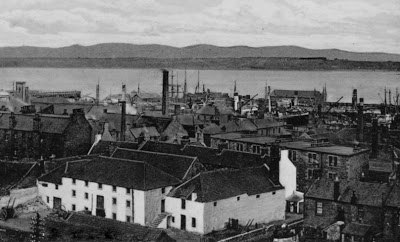

About 1848 or 1849 Daniel became acquainted with John Russell, who was also a miner and an Elder of the Church of Jesus Christ of Latter Day Saints. At their meal hours in the mines religion was discussed. Brother Russell presented the new gospel to the miners. After a thorough investigation of the principles of the gospel and reading “The Voice of Warning” James Hunter, a fellow workman in the mine, asked to be baptized. Daniel, upon learning that Brother Hunter was going to be baptized, hurriedly made up his mind to be baptized also.
On 30 October 1849 Daniel was baptized by Robert Brown and confirmed a member of the Church of Jesus Christ of Latter Day Saints. He was very active in the church, preaching the gospel and baptizing many people. In 1852 Daniel was ordained an Elder. At this time the priesthood was very active and besides their labors in the branch they made appointments in neighboring villages to preach on Sunday afternoons and evenings. Daniel took part with the other brethren until he came to America.
While living in Scotland six children were born to Daniel and Elizabeth. Five of the children died in infancy. On 4 May 1856 Daniel, his wife, and their six month daughter Agnes sailed from Liverpool England for America. They arrived in New York on 14 June 1856 on the ship “Thornton”. They went from New York to St. John, Perry County, Illinois where they lived for five years (1856-1861). The 1860 census of Perry County shows Daniel as a miner with a personal estate valued at $400.00.
While working at the mines to earn enough money to travel to Utah he was hurt quite badly. It took four men to remove the rock that had fallen on him. The doctors did not give him a chance to live, but through his faithfulness, he told them he would live and bring his family to Utah. He was laid up for about 16 months. While in St. John my Grandfather, Hugh Owen, and another baby girl, Eliza was born. In 1861 the family left Illinois and came to Utah. They had many hardships on the plain. While travelling on the plains, another baby girl was born to them, but he only lived a few days. They were forced to wrap her in a heet and bury her in a shallow grave.
The family arrived in Salt Lake City and was met by Archibald McFarland, a very good friend from Bo’ness Scotland. They came to West Weber to live and her lived in a dugout. Daniel worked as a farmer and was a good hard worker. He owned a great deal of land in West Weber, but was in poor health, so he had to sell part of his land. He helped with the cricket drive, they made lye soap, candles, molasses, carded wool, and spun yarn to make their clothes. He also made dobe bricks to build his family house.
He was always a very faithful member of the church, being strict about the word of wisdom, paying an honest tithe, and being prayerful. He baptized many into the church in the West Weber Ward.
On 1 November 1886, at the age of 63, Daniel died in West Weber of paralysis and was buried in the West Weber Cemetery. He was survived by his wife and three children; Agnes McLean Tracy, Hugh Owen McLean, and Margaret McLean Hogg (our ancestor).

Biography by Grace McLean:
“Elizabeth Smith was born December 21, 1828 in Bo’ness, West Lothian, Scotland. She was the daughter of Thomas Smith and Ann Smith. She was the second child and oldest daughter in a family of five children. When she was six years old her Mother died of Cholera. Elizabeth and her brother James went to live with her maternal grandmother, Elizabeth Smith, and her sister Charlotte. Her six month old baby brother Thomas went with their paternal grandmother Charlotte Bravon Smith. The oldest child Thomas had died of whooping cough at the age of three.
She was 18 years old when she married Daniel McLean on 16 April, 1847. Daniel had joined the Church of Jesus Christ of Latter Day Saints in 1849; Elizabeth was baptized into the church on September 20, 1850.
While living in Scotland six children were born to Daniel and Elizabeth. Five of the children died in infancy. In 1856 they decided to leave their home at 33 New Town in Bo’ness, West Lothian, Scotland and come to America. On 4 May 1856 Daniel, his wife, and their six month daughter Agnes sailed from Liverpool England for America. They arrived in New York on 14 June 1856 on the ship “Thornton” (1600 tons). They went from New York to St. John, Perry County, Illinois where they lived for five years (1856-1861). The 1860 census of Perry County shows Daniel as a miner with a personal estate valued at $400.00.
While working at the mines to earn enough money to travel to Utah he was hurt quite badly. It took four men to remove the rock that had fallen on him. The doctors did not give him a chance to live, but through his faithfulness, he told them he would live and bring his family to Utah. He was laid up for about 16 months. Elizabeth worked hard caring for her family and for another miner who lived with them. While in St. John my Grandfather, Hugh Owen, and another baby girl, Eliza was born.
In 1861 the family left Illinois and came to Utah. They had many hardships on the plain. While travelling on the plains, another baby girl was born to them, but he only lived a few days. They were forced to wrap her in a sheet and bury her in a shallow grave.
The family arrived in Salt Lake City and was met by Archibald McFarland, a very good friend from Bo’ness Scotland. They came to West Weber to live and there lived in a dugout. Daniel worked as a farmer and was a good hard worker. He owned a great deal of land in West Weber, but was in poor health, so he had to sell part of his land. He helped with the cricket drive; they made lye soap, candles, molasses, carded wool, and spun yarn to make their clothes. He also made dobe bricks to build his family house.
In 1864 when the George Hunter family arrived in West Weber from Scotland, she took the youngest son, James Hunter, and kept him for a year. Her dear friend Sister Hunter had died while en route to Utah, leaving six children. The little boy was only about 1 year old. She was a good and kind Mother to him.
She was always a very faithful member of the church, she always believed in paying a full tithing and donations of all kinds. She was active in the West Weber Ward Relief Society and was a member of its first organization.
He husband died in 1886 leaving her alone, as by the time all her children were married. She was comfortably fixed and had plenty to live on.
Elizabeth died on March 24, 1896 in West Weber and was buried in the West Weber Cemetery.”

Jonah and Eliza Orgill Croxall
The Croxalls were converted to Mormonism in England. They sailed to Boston in 1857 and traveled to Trento New Jersey and later to New York City. Jonah was the president of the New York Conference.
The family crossed the plains to Utah in 1861. At this time we don’t know any details about their journey.
Jonah Croxall and Mary Elizabeth “Eliza” Orgill
Jonah was from Darbyshire, England. Jonah married Eliza Orgill in England. They converted to Mormonism and Jonah was baptized June 27, 1849.

The Croxall family sailed to America in 1857 landing in Boston. They moved to Trenton, New Jersey and some months later to New Your City, where he was president of the New York conference. Our ancestor Mary was born Feb. 1861 in New York.
The family emigrated to Utah in 1861. We know they left Florence, Nebraska July 4, 1861 with a wagon company lead by John R. Murdock. There were 50 wagons in the company and their eldest son Mark was the camp musician. They reached Salt Lake City September 12, 1861 after “a hot dusty trip”. The first documentation to place them in Utah is the christening of the child 6 Feb. 1862, prior to the arrival of that season’s emigration.
Jonah was a potter in England. The name Croxall means to make crocks and pots. Jonah Croxall was one of a group of Staffordshire potters operating in Salt Lake City from the 1860s to 1880s. He was a co-owner of City Pottery during that time.
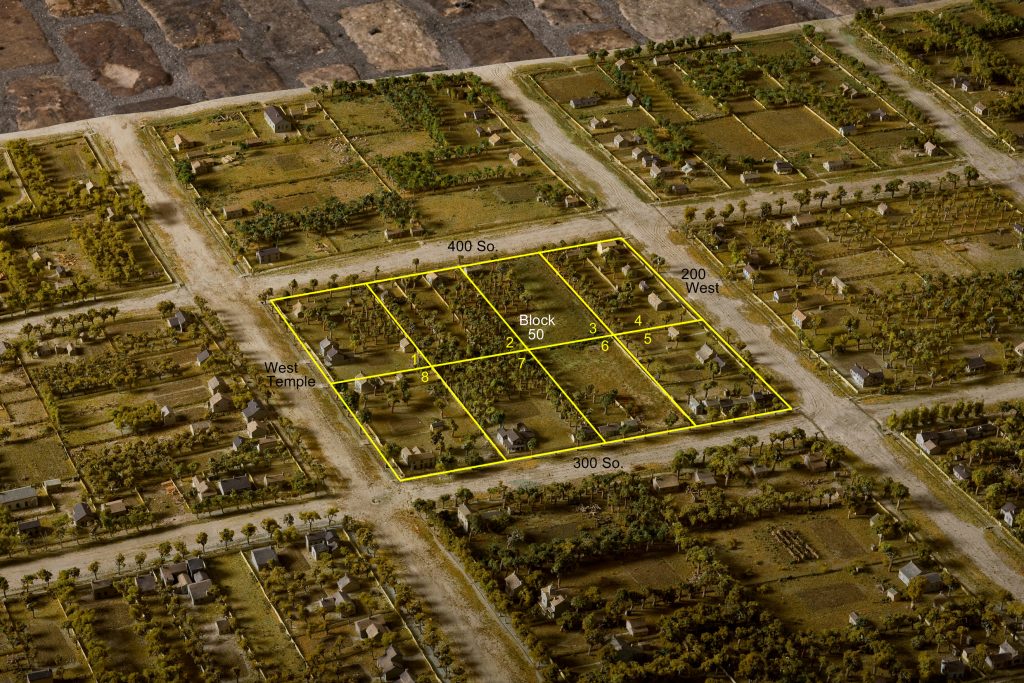
In Salt Lake he formed “Croxall’s Band” featuring his eldest son Mark playing the coronet. Mark later married two of Brigham Young’s daughters.
Our Ancestor, and their daughter Mary, married Richard Andrew the son of the immigrant blacksmith, Frederick Andrew.
The family home was on the North side of South 400 St. between 200W and S. Temple, two blocks east of Pioneer Park. They were members of the original 7th Ward along with their future son-in-Law Richard Andrew. Richard’s family blacksmith shop and home were at the corner of 400 South and Main Street.



This is an image of a makers mark “Croxall and Cartwright City Pottery SLC” with a small Eagle

William and Nannie Farley Lowe
William emigrated from Stockport England to St. Louis in 1847 He served in the Union Army during the civil war. He married Nannie Martin Farley in Rollo, Missouri in 1863. Her family was descended from 17th century colonial Virginia immigrants. Sometime before 1874 they are converted to Mormonism and travel to Utah arriving in 1874. By that time the transcontinental railroad was operating, so it’s unlikely they came over on covered wagons, but we don’t know any details about their journey.